

THE RIGHT 40
SUCCESS
HUNT WHEN YOU CAN
David Reitz didn’t let bad weather hamper his pursuit of a trophy Pennsylvania buck. In fact, his rainy-day hunt over a Whitetail Institute food plot proved to be memorable. ❚ By Gordy Krahn
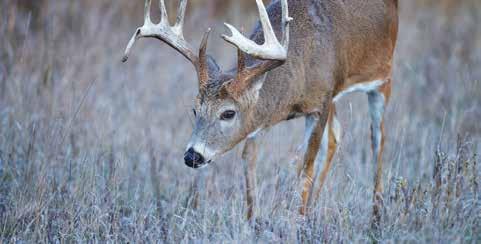




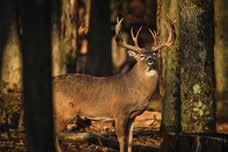
EIGHTEEN ACRES AND A DREAM
How one New York State hunter carved a food plot out of nothing and killed his best archery buck.
SUCCESS MANAGEMENT
Bestul


IN THIS ISSUE ■ ISSUE 32-2
❚ By Scott
It doesn’t take a lot of land to grow big deer, and Nathan Curtis is proof. Learn how this Indiana hunter used careful food plot management to take the buck of a lifetime. ❚
FEATURES OFFICERS AND STAFF WILLIAM COUSINS / VP/GM WHITETAIL INSTITUTE BRANDON SELF / DIRECTOR OF OPERATIONS DAWN MCGOUGH / BUSINESS OPERATIONS MANAGER JOHN WHITE / INSIDE SALES MANAGER TYLER HOLLEY, CHASE DUNCAN, DANE RUSSELL / INSIDE SALES REPRESENTATIVES DREW GILKERSON / NATIONAL SALES MANAGER CLARE HUDSON / TERRITORY MANAGER, NORTHEAST JOE THOLE / TERRITORY MANAGER, MIDWEST DR. CARROLL JOHNSON, III, DR. JOYCE TREDAWAY /
MARK
MARKETING/COMMUNICATIONS
SCOTT
WADE
DEPARTMENTS HOME ON THE RANGE Create core areas rather than just locating them. Learn to recognize what deer want, and then make it happen. ❚
THE MANY BENEFITS OF RADISHES This member of the mustard family is good for the soil and environment, and highly praised by agronomists. And it attracts loads of deer.
FOOD PLOTTING 22 HOW TO CHOOSE AN IDEAL FOOD PLOT LOCATION If you’re new to food plotting or your current plot location lacks deer activity, let these parameters guide you in choosing the best location your property offers. ❚ By Darron McDougal FOOD PLOTTING 26 FIND YOUR PATH Put one foot in front of the other along good entry and exit routes this season. ❚ By Josh Honeycutt FOOD PLOTTING 30 THE WINTER WOES: DEER MANAGEMENT THROUGH THE COLDEST MONTHS Land managers can take several steps to help deer survive the frigid lean season. ❚ By Matt Harper MANAGEMENT 36 54 58 62 MANAGEMENT KNOWING YOUR OAKS Woodsmanship is a dying art, but one way to revive it — and your deer hunting success — is to learn your oak trees. ❚ By Josh Honeycutt 48 14 THINGS HAVE CHANGED Successful food plotting involves many more considerations than early efforts decades ago. But as modern land managers know, the effort is well worth it. ❚ By
Almy 43 4 | A MESSAGE FROM THE GM 6 | SCIENTIFICALLY SPEAKING 10 | ADVANCED FOOD PLOTTING 66 | MY TROPHY WHITETAILS 74 | BACK-40 NOTEBOOK 58 14 FOOD PLOTTING FROM JUNGLE
THE
FOOD
Most land managers know the basics of clearing and starting a new plot. However, fresh plots in remote locations introduce several challenges. Here’s how to do it right. ❚ By Matt Harper 18 FOOD PLOTTING Vol. 32-2 | Whitetail News 3
By Scott Bestul SUCCESS
AGRONOMIST AND WEED SCIENTISTS
TRUDEAU / RESEARCH AND DEVELOPMENT JON COONER /
MANAGER BRIAN LOVETT/ WHITETAIL NEWS SENIOR EDITOR
BESTUL / EDITOR GERALD ALMY, KRIS KLEMICK, MATT HARPER, MARK OLIS / FIELD EDITORS JEREMY FLINN, MICHAEL VEINE, DARRON MCDOUGAL, JOSH HONEYCUTT, BOB HUMPHREY / CONTRIBUTING WRITERS
ATCHLEY / ATCHLEY MEDIA ADVERTISING DIRECTOR
By Bob Humphrey
By Gerald Almy
Gerald
TO EDEN:
CREATION OF A
PLOT
Rest In Peace
RAY SCOTT
The Whitetail Institute will mark its 35-year anniversary in 2023; the same anniversary as the food plot and deer nutrition industries. All share the same origin: They were born from one revolutionary idea of Ray Scott that food plot plantings could be scientifically designed for white-tailed deer.
After a long and fulfilling life of 88 years, Ray passed away peacefully on May 8th. I was fortunate to be the first person on board with Whitetail Institute to mentor under him.

The wider world will remember Ray’s enormous contributions to the sporting and conservation world in founding the Bass Angler’s Sportsman’s Society and for the many accolades and awards he received during his life for conservation and stewardship. We who are so fortunate to have known and worked with Ray at Whitetail Institute of North America will always be deeply grateful for the opportunities we had to walk with him in his achievements as a pioneer and trailblazer in the food plot industry as he brought his vision to reality.
With the introduction of Whitetail Institute in 1988, Ray brought to fruition his idea that the science of breeding plant varieties for specific purposes, which had been used for many years in wider agriculture, could be applied to create new plant varieties used in food plots for deer. Ray also instilled in all of us at Whitetail Institute his business approach, which focused entirely on product quality and customer service. Whitetail Institute is committed to continuing that philosophy.
Ray was a pioneer, visionary, out-

4 Whitetail News | Vol. 32-2
William Cousins VP/GM Whitetail Institute
doorsman, legend and land steward. He will be missed by many and left an undeniable legacy on this earth. We know he is fishing the best lakes and hunting over the prettiest green clover
fields in heaven. Rest in peace to our founder, and my friend Ray Scott.
— William
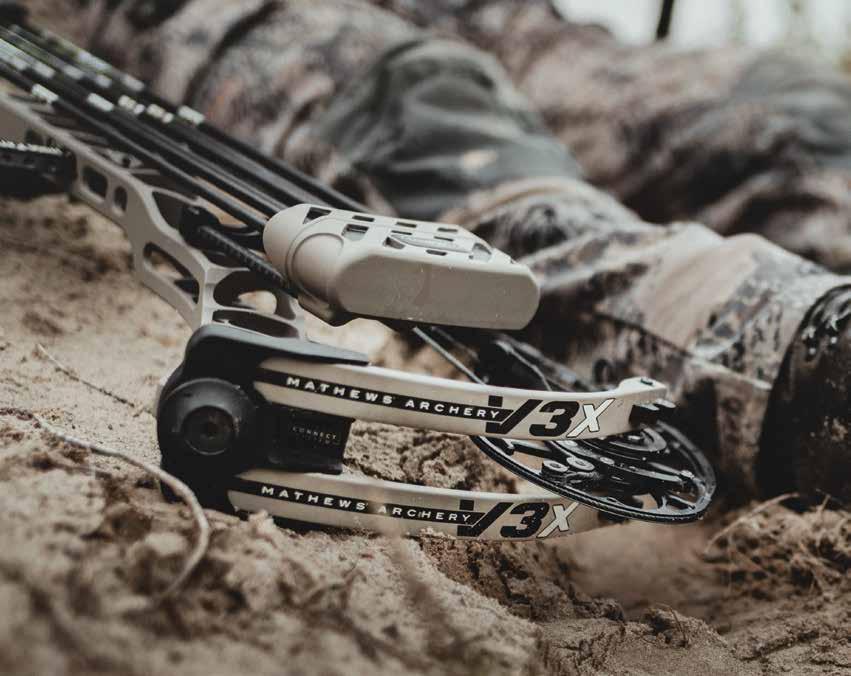







LEARN MORE ABOUT THE V3X AND OUR NEW INTEGRATED LINE OF ACCESSORIES AT MATHEWSINC.COM
THE CULMINATION OF 30 YEARS OF ARCHERY INNOVATION.
SCIENTIFICALLY SPEAKING
■ by W. Carroll Johnson III, Ph.D. – Agronomist and Weed Scientist
POTASSIUM:
■ This is an example of an excellent stand and growth of Imperial Whitetail Clover after a supplemental application of 8-24-24 fertilizer.

This site was extremely low in phosphorous and had marginal levels of potassium.
AN ESSENTIAL AND OVERLOOKED MACRONUTRIENT
Potassium is the final macronutrient discussed in the series on essential nutrients for crop growth. As a recap, macronutrients are essential nutrients needed in relatively large amounts for optimized crop growth. The three macronutrients essential for plant growth are nitrogen (profiled in Whitetail News 31-3) phosphorous (issue 32-1) and potassium.
To set the stage, let’s define some terms. The symbol for potassium in the periodic table of elements is K, which is the abbreviation for the Latin word kalium. Potash is a potassium-rich salt mined in the form of several potassium-bearing minerals. The most common form of mined potash is potassium chloride. A synonym of potas-
sium chloride is muriate of potash. In most food plot fertilizers, potassium is provided in the form of muriate of potash (potassium chloride). Potash could become a commodity of strategic importance in the near future. In 2018, Canada provided 28.5 percent of the world’s mined potash. Russia, Belarus and China collectively provided 47.4 percent of the world’s potash. You can reach your own conclusions on the importance of that data in the context of the events of 2022.
In practical terms, potassium is the third numeral in the fertilizer composition sequence: N, P and K. For example, the blended turfgrass fertilizer 16-4-8 contains 8 percent potassium. The fertilizer 13-0-46 (potassium nitrate) contains 13 percent
nitrogen, no phosphorous, and 46 percent potassium. Chemically, elemental potassium is a highly reactive cation, in which the element has a net-positive charge, which is important to know when studying the behavior of potassium in the soil. Cations such as potassium typically bond with anions (elements that have net-negative charge) such as chlorine, which explains why muriate of potash is the most common form of potassium fertilizer.
The role of potassium in crop physiology is broad-based and subtle. Generally, potassium helps overall plant growth and vitality by increasing root growth, serving as an enzyme for processes associated with plant growth, building cellulose, reducing water loss and controlling plant integrity.
6 Whitetail News | Vol. 32-2
The role of potassium in crop physiology is broad-based and subtle, and crops have overall poor vigor and longevity when this macronutrient is deficient.
We live in a connected world. Why should your Trail Camera be any different? Our proven HyperFire 2™ camera is now 4G LTE Cellular Enabled, allowing you to receive images from your camera almost anywhere in the world via email or through our Mobile App for Android® or iOS®. Cost effective data plans utilizing Verizon® or AT&T® are available directly through RECONYX and start at only $5 per month, with no long term contracts. With our Mobile App, you can create a custom cellular plan, manage images and check status or change camera settings from anywhere. All RECONYX® HyperFire 2™ Cameras are Made in the USA and are backed by a full 5 year warranty. RECONYX®, See What You’ve Been Missing…





































HYPERFIRE 2 4G LTE CELLULAR RECONYX.COM MADE IN USA @RECONYX_CAMERAS
“
When listed, the benefits of potassium are vague. However, crop plants have overall poor vigor and longevity when potassium is deficient.
Potassium is a mobile element in crop plants. Symptoms of potassium deficiency include yellow spots along the margins of older leaves. Plants actively transport potassium in the vascular system from older leaves to younger and more photosynthetically active leaves when the element is in short supply.
Because potassium is chemically a cation (net-positive charge), any discussion of potassium as an element essential for plant growth must include the cation exchange capacity of the soil. The cation exchange capacity is a property of a soil that contains net-negative charges on the clay fraction and organic matter that temporarily retain positive charged cations such as potassium, calcium and magnesium. Cations such as potassium are not permanently bound and are later released for plant uptake. Some soils are loaded with clay and organic matter binding sites (high CEC) and can store potassium.
In contrast, some soils have few binding sites (low CEC). Additionally, CEC varies widely among clay types. Why is this relevant in the potassium discussion? The CEC of a soil and the presence of bound potassium on the binding sites affects the amount of potassium fertilizer recommended in the soil test report. Sandy soils have very few negative binding sites and thus a low CEC. Those soils routinely require supplemental potassium every year because of the inability of the soil to store potassium and because the element leaches away. In contrast, soils in the Midwest are composed of a different clay fraction with numerous binding sites for cations. In those soils, potassium is not as prone to leach. Soil
testing laboratories routinely measure the CEC of a soil sample, and fertilizer recommendations are adjusted according to the CEC.
Clover such as Imperial Whitetail Clover and alfalfa (Alfarack) have unusually high potassium requirements.
Potassium deficiency in either will cause the previously described plant symptoms, which eventually reduce forage productivity and longevity of the food plot. Both legume forages also have a unique quirk related to potassium uptake: They will absorb more potassium than needed if excess potassium is present in the soil. This is called luxurious consumption. The major problem with luxurious consumption of potassium is increased cost of fertilization without any corresponding increase in forage productivity.
Given the significant increase in fertilizer cost in 2022, luxurious consumption of potassium caused by excessive fertilization is cost prohibitive and unnecessary for maximum forage productivity. This is an important justification for soil testing and after fertilizer recommendations provided in the final report.
In issue 32-1 of the Whitetail News, I discussed the macronutrient phosphorous. In that article, I referenced a situation in central Georgia where phosphorous was deficient (basically nonexistent) in the soil, which stunted clover growth. That soil test indicated that potassium was not as deficient but still needed to be supplemented. The fertilizer chosen by the landowner was 8-24-24, which was the best blended fertilizer locally available that was suitable for both nutrient deficiencies and ideal for use on clover. That fertilizer contains 24 percent phosphorous and 24 percent potassium. The rate chosen addressed the glaring phosphorous deficiency and
also met the high potassium requirement of clover. Two food plot managerial problems were solved. The result was superb clover growth. This a real-world example that illustrates what it takes to correct multiple nutrient deficiencies to ensure a successful food plot.
Fertilizer costs have skyrocketed in recent months. Some of this is because of inflation, and some is because of international events. How long these increases will continue is beyond my knowledge or insight. Properly managing food plots that achieve the desired forage quality and quantity often require supplemental nutrients, usually in the form of fertilizer. To use the cliché, ignoring soil fertility deficiencies during the period of high fertilizer prices is penny wise and dollar foolish. This is especially the case when the cost of limestone and fertilizer is compared to the total cost of managing property for wildlife and hunting sports. Yes, the high cost of fertilizer is real front-pocket money, and that cannot be ignored. However, food plots with marginal productivity because of nutrient deficiencies are even more costly because of unfulfilled potential. The best way to address the high cost of fertilizer is to improve fertilizer use efficiency by lessening waste and maximizing forage crop return on fertilizer investment. Potassium needs in food plots are no different.
My colleague Joyce Tredaway recently discussed (in issue 32-1 of Whitetail News) the broad strategy of food plot management when fertilizer prices are high. I encourage everybody to read that article.
8 Whitetail News | Vol. 32-2
SCIENTIFICALLY SPEAKING
“LUXURIOUS CONSUMPTION OF POTASSIUM THROUGH EXCESSIVE FERTILIZATION IS COST PROHIBITIVE AND UNNECESSARY FOR MAXIMUM FORAGE PRODUCTIVITY.”

ADVANCED FOOD PLOTTING
State-of-the-art tips and techniques for high-level land managers
■ by Joyce Allison Tredaway, Ph.D. – Agronomist and Weed Scientist
PERENNIAL GRASS WEEDS:
IDENTIFICATION AND CONTROL
Whitetail Institute often receives phone calls and emails about “grasses” that were sprayed with Arrest Max and not killed. We then request photos of the grass that wasn’t controlled and discover it’s actually a sedge or rush. Before a management plan can succeed, it’s imperative to correctly identify a plant.
Unfortunately, grasses can be difficult to distinguish when they emerge and are often not identified until they flower. Delayed control measures lead to increased early-season crop-weed competition and reduced control of larger weeds.


Identifying Grasses
Identifying grasses, whether they are weeds, can be easier if you familiarize
yourself with their basic parts. Rhizomes are underground stems, and stolons are above-ground stems. Both are capable of rooting and forming a new plant genetically identical to the parent plant. The roots function to anchor plants to the soil, as storage organs, and to absorb and conduct water and essential minerals from the soil. The tiller is an above-ground branch on a grass plant. The collar region of the leaf blade is most useful for identifying grasses before they flower. The collar marks the junction between the blade and the outer sheath on the outside of the leaf. It consists of the leaf blade, sheath, ligule and auricles. The internode is the area between nodes. The node is the solid region on the stem that gives rise to the leaf sheath.
In some grass species, the lower nodes might contain adventitious buds capable of producing new tillers. The leaf sheath is the lower section of a grass, enclosing its associated internode. The leaf blade is part of the leaf above the sheath, also known as the lamina. The inflorescence, or seedhead, is the flower head terminating the stem, consisting of a collection of flowers arranged on a common axis. There are three main grass inflorescence types: panicle (fall panicum), spike (foxtail) and raceme (dallisgrass).
To further help identify a grassy weed, you must distinguish the differences in the collar region. The grass plant might not have auricles, which are claw-like appendages at the base of the leaf blade that tend to clasp the leaf sheath at the inter-
10 Whitetail News | Vol. 32-2
Weedy perennial grasses can be a nuisance. Learn to beat them with proper identification and smart control practices.
THE WORLDS MOST ACCURATE CROSSBOWS.







MISSIONCROSSBOWS.COM
MADE IN THE USA FROM THE FIELD, TO THE PODIUM the SUB-1 SERIES delivers an unmatched shooting experience in the field, or in competition. Discover the World’s most accurate crossbow series that took 10 / 10 WINS , 29 / 30 TOP 3 , 48 / 50 TOP 5 and 90 / 98 TOP 10 finishes for the 2021 competitive season.
ADVANCED FOOD PLOTTING
State-of-the-art tips and techniques for high-level land managers
node. The ligule is a structure on the inside of the collar. It can be membranous or hairy, or it might not be present. The ligule might exhibit a smooth margin or toothed margin. The midvein is the central or main rib of a leaf.
In addition, pubescence (leaf hair) is often critical for identifying grasses. Pubescence can appear in several areas on a grass plant. It can be located only on the leaf sheath margin, over the entire outside of the leaf sheath surface, on the leaf collar margin, as a ring-like appearance surrounding the entire collar, on the leaf blade margins or leaf edges, or only on the blade surface, with hair absent over the other parts of the plant. Leaves or other plant surfaces without pubescence are often referred to as glabrous.
After you’ve properly identified a grass, several practices can favor the growth of desirable plants. These include maintaining proper soil pH and fertility levels, mowing at the proper times and stage of maturity, using tillage and applying herbicides correctly.
Maintaining Proper Soil pH and Fertility Levels
Although there are exceptions, most weeds do not compete well with a dense stand of desirable foot plot species. Therefore, managing food plots to favor the vigorous growth of those species will minimize the effects of weedy species. Adjusting the soil pH and nutrient levels according to soil test recommendations helps increase the stand density of desirable food plot species. However, those practices alone are not usually effective in eliminating established weeds. In fact, some perennial weeds such as curly dock, although not a weedy grass, can respond favorably to fertilization and grow well in fertile soils. Therefore, giving the competitive advantage to food plot species will help it outcompete grassy weeds in the soil bank.
Mowing at Proper Timing and Stage of Maturity
Timely mowing or clipping of food
plots can be beneficial for suppressing weedy erect perennial grasses. A primary benefit of mowing is to prevent or reduce seed production and spread of undesirable plants. Therefore, mowing should begin when weeds are in the stem elongation stage but before seed heads are produced. Mowing fields after weed seeds become mature offers little benefit to minimize future weed problems. Frequent mowing, repeated for three to five years, can deplete root reserves of some perennial grasses, such as johnsongrass. This practice will help suppress their growth and reproduction.
Tillage
Tillage kills perennial weeds by physically damaging the vegetative reproductive parts (rhizomes, stolons, bulbs and corms). Tillage can also leave the reproductive parts on the soil surface, exposing them to environmental conditions such as freezing or drying conditions, and repeated cultivation can weaken the plant through carbohydrate depletion. Harrowing multiple times before seeding food plots can also contribute to weed suppression. Much of a potential weed population can germinate before planting food plots. Reworking the ground with a harrow just before planting will help suppress weeds. Tillage also breaks apart thick mats of perennial grasses and stimulates regrowth that can be targeted by systemic herbicides such as glyphosate, glyphosate plus 2,4-D or triclopyr.
Proper Herbicide Use
Perennial grasses can be effectively managed with the correct herbicide and proper timing. If you have only broadleaf mixtures such as Imperial Whitetail Clover, Fusion, PowerPlant or Ravish Radish, you can safely spray Arrest Max over the top of your plots. Always include a crop oil such as Sure Fire with Arrest Max for it to work properly. Optimum performance of Arrest Max depends on several factors when treating perennial grasses. These include the weedy grass targeted, the height of weedy grass and
the pressure of the grassy weeds you are targeting. These factors determine the proper Arrest Max rate, the weed height that you should spray and whether a re-treatment will be necessary. In addition, if you have a mixed grass species population, you must treat the first grass weed species when it reaches the specified height on the Arrest Max label.
The rate and timing of Arrest Max depends on the perennial weed you are trying to control. For example, if you have wirestem muhly, the recommended weed height for the first and repeated applications if regrowth occurs is 4 to 8 inches. The rate recommended is 12 to 32 fluid ounces per acre, but a maximum of 32 fluid ounces per acre can be applied. Therefore, if a repeat application is necessary, two applications of 16 fluid ounces per acre could be applied. Rhizome johnsongrass is recommended to be applied at the 12- to 24-inch height at a rate of 12 to 32 fluid ounces per acre for the first application and 6to 18-inch height for the second application at a rate of 9 to 24 fluid ounces per acre. I’ve seen good control using the 16-fluid-ounce-per-acre rate on the first application closer to the 24-inch height. A second application at the 16-fluidounce-per-acre height could then be applied if regrowth occurs.
Weedy perennial grasses are a nuisance for food plots but can be controlled if you take the proper steps. Identifying a grassy weed while it’s small is critical to success. Your food plots should be given every possibility to succeed. This can be accomplished by optimizing soil fertility and pH, mowing at the correct times, using tillage for seedbed preparation and as a tool with systemic herbicide, and applying herbicides correctly.
12 Whitetail News | Vol. 32-2

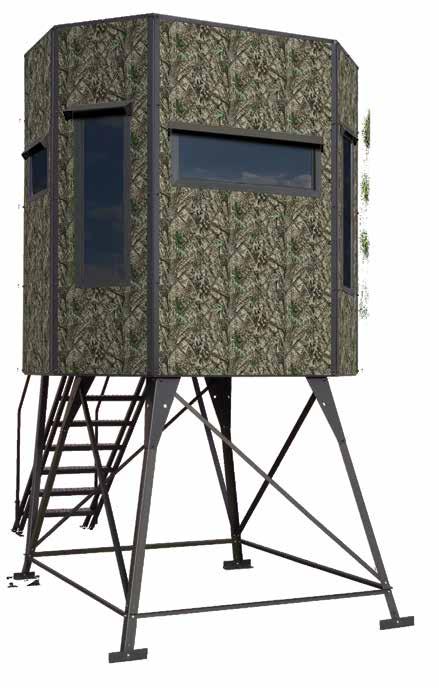














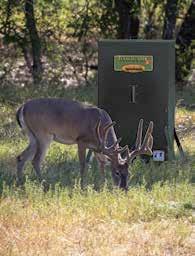
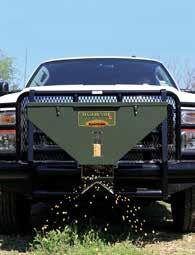





























YOUR CHOICE RIFLE BLIND • COMBO RIFLE / BOW BLIND GROUND LEGS • 4' TOWER • 8' TOWER America ’ s Choice For Outdoor products WHERE ALMOST REAL ISN’T REAL ENOUGH. Dale Earnhardt Jr. “TrueTimber has created top-ofthe-line patterns and established itself as the innovator of the most realistic and virtually undetected camo designs.” FISH FEEDERS STAND & FILL FEEDERS GREAT SELECTION OF OUTDOOR PRODUCTS ROAD FEEDERS PROTEIN FEEDERS 3350 IH 35 N, San Antonio, TX 78219 • 800.969.3337 www.TexasHunter.com CELEBRATING 65 YEARS PLUS BUILT IN AMERICA For More Details & Videos Request a Catalog
■ Nathan Curtis’ 2021 buck scored 183 inches and had great mass, including 8-inch circumferences at the bases.
CURTIS
THE RIGHT 40
It doesn’t take a lot of land to grow big deer, and Nathan Curtis is proof. Learn how this Indiana hunter used careful food plot management to take the buck of a lifetime.

14 Whitetail News | Vol. 32-2
NATHAN
■ by Scott Bestul
The oldest rule of real estate emphasizes location. Whitetail nuts can add their own addendum — one that stresses management. Indiana hunter Nathan Curtis combined those factors this past fall to take a giant buck on a 40-acre tract he and his brother manage.
“We were first aware of the buck in 2018,” said Curtis, a railroad engineer. “He was a regular at one of our mineral sites, which we load up with 30-06 mineral. We think he was 2-½ years old that year and that he would be a special deer if he could make it a couple of more years. The next year, he showed up at the mineral site almost to the day from the year before, and it was clear he’d made a big jump. Then he kind of disappeared that year. Our neighbor had done some logging on his property, and I won dered if that ran him off, or if something in his world had just changed enough that we weren’t seeing him or getting pictures.

But the next year, the buck returned right on schedule.
The Pursuit
“And that year, he’d just exploded,” Cur tis said. “I felt like he would gross over 200 inches. I’m convinced the mineral sites and food plots, which, except for some corn and beans we plant, are all Whitetail Institute stuff, are the major contributors to his big jumps in antler growth. I hunted him that fall to the exclusion of all other deer and just never had a chance at him. And it’s not like he was nocturnal. We had plenty of daylight pics of him, especially in late muzzleloader season. He was absolutely killing our Fusion plots, and later in fall, he was all over the Beets and Greens. I still shake my head about not being able to see him that year. It was either a case of wrong place, wrong time or maybe he was busting me going in to my stand. I guess I’ll never know, but it sure wasn’t for lack of effort. I lost track of the 150- to 160-inch bucks I let walk just holding out for him.”
The next fall, however, things took a huge turn for the better for Curtis.
“He’d put on tons more mass, but I think his overall score had gone down a bit, and I don’t know why,” Curtis said. “Still, he was one amazing deer, and I was devoting all my effort to him again. On the afternoon of Oct. 3, I was in a stand overlooking a plot that I’d put two varieties of seed in — Pure

Attraction in one strip and Beets & Greens in the other — and at 5 p.m., I watched a big buck walk through that plot and then kind of slip back in the timber. I grabbed my rattling antlers and hit them a few times, and about 30 seconds later, I saw this giant silhouette across the field. I looked through my binoculars, and it was him.”
The buck turned toward Curtis and began walking at him, straight across the field.
“There’s a tree about halfway between us, and he stopped to rub that tree,” Curtis said. “I was shaking so bad when he first started coming at me, but the closer he got, the more I calmed down. There were three does in the plot when he started coming, and they ran toward me until they were right by the stand. I was wondering, ‘How am I going to pull this off?’ when the buck turned broadside at 40 yards. I drew the bow, picked my spot and hit exactly where I was aiming. The buck trotted off about 40 yards and tipped over. It was an amazing hunt, especially with rattling him in, and I will probably never top it, but I don’t care.”
The Curtis buck was a giant, grossing 183 inches B&C.
“The thing that impressed me the most was his mass,” Curtis said. “He had 8-inch circumferences at the bases and just carried his mass everywhere. He had kickers off his G2s and G3s, and super tall tines. And this is crazy, but his G2s were even taller — I’m guessing close to 15 inches — the year before.”
The Management Difference
Curtis credits the addition of high-quality food and mineral to improved deer numbers and quality on a farm he’d hunted since his start.
“This 40-acre property has been in my family forever,” he said. “I actually didn’t start deer hunting until I was 20, when my brother finally got me into it. It’s mostly hardwoods, but there’s a 9-acre field in the middle of it, plus a couple of smaller openings and a pond. When I first started hunting, it was common to see only three to five deer on a good hunt. Then my brother and I started reading about management and food plots and turned to the Whitetail Institute for products. At first, we took shortcuts, like I suppose a lot of guys do. Finally, we realized if we were going to do this, we should try to do it right, and we couldn’t believe the difference.
Vol. 32-2 | Whitetail News 15
IMPERIAL WHITETAIL 30-06 Mineral/ Vitamin Supplement ■ Delivers essential macro and trace minerals, and vitamins A, D and E, which are needed for a healthy herd and for bucks to reach more of their genetic potential in antler growth.
increases calcium and phosphorus uptake to
growth and
improves
Antler Up D3
promote
development of antlers. Promotes heavier body weights and
the overall health of deer.
“
“I WAS SHAKING SO BAD WHEN HE FIRST STARTED COMING AT ME ... ”
■ Curtis said he got serious about whitetail management about seven or eight years ago, and the results have been impressive.




It was just crazy. All of a sudden, we went from seeing a handful of deer to 20 or 30 on a normal hunt.”
The Curtis brothers initially focused their food plotting attention on the 9-acre interior field.


By Ranew’s Outdoor

“It’s a fairly rectangular field that had been mostly switchgrass and other natives,” he said. “I bush-hogged it to create two circular Equipment® THEFIRMINATOR.COM 678.544.4400 WYANCY@RANEWS.COM
G3
Expect from your food plot equipment. more MADE IN AMERICA. BUILT TO LAST.
The Firminator G-3 models feature 16-inch or 18-inch ground turning discs, a seed hopper featuring the precision Accurate Seeding System, and a true agricultural-grade, cast-iron cultipacker. The G-3 is available in a compact ATV unit and 4-foot, 5-foot, 6-foot or 8-foot tractor units for premium results. G3 ATV MODEL
MODEL
plots, one on the north side and the second on the south. We rotate these between various Whitetail Institute varieties. Recently, we added a 20-foot-wide, 200-yard-long plot along the west side of the field. It’s just a long strip that I planted to Pure Attraction. We keep a path mowed along the edge of the field and then mowed lanes between each of the plots. We kept the switchgrass separating each plot so deer feel safe feeding in there, not like they’re just stepping out in one big field.”
As Curtis and his brother saw the appeal of those initial plots to deer, they looked for other potential sites.

“We had another 1-acre opening, and we got some Imperial Whitetail Clover going in there,” he said. “And we do have a couple of other spots where we’ve planted Roundup-ready corn and soybeans. Between those and our 30-06 mineral sites, I feel like we’ve maximized the potential for feed and attraction on the property. By summer, the mineral and clover are bringing deer in, but it just seems to get better as the year progresses. We’re surrounded by lots of big agricultural land, and once
IMPERIAL WHITETAIL
FUSION
■ Perennial three- to five- year longevity.
■ Available in 3.15 pounds (plants .5 acre) and 9.25 pounds (plants 1.5 acre).

■ A premium food plot mix of Imperial Clover plus the added benefit of exclusive WINA Chicory.

■ Engineered for forage production all year, even during drought conditions in the hot, dry summer months.




the crops get harvested, we’re the only food in the neighborhood. That’s when it really gets good.”
Going Forward
Curtis’ land management experience only fueled his passion for whitetails and deer hunting.
“We started getting serious about things seven or eight years ago, and seeing what a difference it made just hooked me,” he said. “I’m able to save some nice vacation time, and when fall comes, I’m able to spend some time in the woods doing what I love. And while I might have shot my once-ina-lifetime buck, that doesn’t mean I won’t keep at it and enjoy the whole process. Besides, I’ve already got trail-cam pics of a buck that has to be the son or grandson of the buck I killed, so you never know.”
MAXHERBICIDE WHITETAIL INSTITUTE
MAX
www.brillionfarmeq.com Set Your Sights on Brillion Farm Equipment Brillion Farm Equipment offers a full-line of equipment suited for food plot enthusiasts. The Food
is an all-in-one solution for food
handling seedbed preparation,
Brillion, WI 54110 855.320.0373 ©2021 Brillion Farm Equipment www.facebook.com/landollag Till ‘N Seed® Model BPSBA-8 Food Plot Seeder Model FPSB-6 The Till ‘N Seed is now available in 8’ working widths in pull-type or three-point hitch configurations.
Plot Seeder
plots
seed metering and placement, as well as seedbed finishing. Brillion’s ground driven Till ‘N Seed® shreds existing food plots and plants numerous food plot seed mixtures. All products are backed by Brillion’s years as an industry leader in the Seeder and Pulverizer industry!
THE CREATION OF A FOOD PLOT
FROM JUNGLE TO EDEN
Most land managers know the basics of clearing and starting a new plot. However, fresh plots in remote locations introduce several challenges. Here’s how to do it right.

18 Whitetail News | Vol. 32-2
■ Text and Photos by Matt Harper
Idon’t like hot, humid, muggy treks through tick-infested woods thick with viny vegetation, much of which pokes and rips your skin or leaves you with a breakout you get to enjoy for several days. Yet almost every year, I endure some expedition to discover an area where a food plot would almost guarantee a taxidermy bill at the end of deer season. Never mind that I might have scouted the area several times, because like a sculptor, maybe you just have to look harder to see what’s within after you remove the covering.
In my early days of food plotting, I built plot sites on my parents’ farm, and although Dad loves to hunt, he’s also a farmer, so land that was already cleared or tilled was used for raising hay or row crops, or as pasture for cows. So to plant plots, I had to scavenge through less-used parts of the farm, which typically meant areas not extremely conducive to planting or sowing, at least in the state that I found them. In those days, when I didn’t have a pot to pee in or a window to throw it out of, my area-clearing tools were fairly rudimentary and powered predominantly by my muscle. My arsenal included a chainsaw, a sprayer, rakes, maybe a drag behind a four-wheeler and whatever other hand-powered sweat-inducing device I could drag into the brush.
The results were OK — some better than others — based on the land I picked and the amount of effort I put into the projects. As time passed and I had more money, I upgraded a bit with a small tractor and a self-propelled walk-behind brush mower. Dad actually bought the brush mower, but I logged the miles behind it. By the way, self-propelled does not equate to a leisurely stroll of satisfying land clearing. If you’re on a nice flat piece of land with a well-manicured lane for getting in and out, it might be like the commercials on TV.
But the places I took that contraption were far from picturesque and bordered on suicidal. I remember one ill-conceived food plot enterprise during which I needed to take the mower across a large creek with 8- to 10-feet banks on both sides. You can’t carry the mower. You have to “drive” it, which meant pulling, pushing, hoisting and cussing. I guess really it was
more like carrying it. After I got across, I faced a walk through thick multiflora rose bushes and tree saplings for 400 yards between me and my destination atop an oak flat. After several hours of toil, I was only 100 yards past the creek, and the mower was buried in a brush-hidden ditch. It took me, Dad and a buddy to pull that thing out. No food plot graced the oak flat.
Later, I graduated to a skid loader, bigger tractor and even sometimes a bulldozer. But even now, as my hair starts to show hints of gray, I sometimes walk behind that self-propelled mower — actually I bought one after tearing up Dad’s — in hopes I can build a deer oasis in some remote area where big equipment can’t roam.
Regardless of how you do it and what equipment you use, there are a few tricks and considerations when building remote food plots. The main considerations require you to ask where and how, and you can figure the rest out from there.

Picking the Spot
During my younger days, I often picked areas to build food plots because they just seemed like the right spot. Some were in the right spot, but many were not and just resulted in a lot of work for nothing. I began to change my thinking, not starting with the question of “where?” but rather “why?”.
For example, a classic remote food plot setup involves building a plot between a bedding area and a main food source, such as an agricultural field or stand of white oaks. Why do you want to create this scenario? Usually, you hope deer will stop and use the plot on their way to the larger food source. You’re creating a staging area that has food deer desire. Pretty simple, right? It’s simple in concept but often not as straightforward in practice. For example, if you place your food plot too close to the bedding area, it might make deer use a different bedding area, and it can be difficult to access without busting deer. If you get too far away from the bedding area, you risk deer not showing up until darkness is approaching. So you should put it in the middle? Not necessarily because in some cases, the middle is in an area where it’s impossible to construct a plot.
Vol. 32-2 | Whitetail News 19
Further, you have to consider deer movement. If there seems to be a concentration of deer travel and trails close to a bedding area, and trails spread out from there to nighttime feeding spots, you should cheat your plot closer to the bedding area. In some cases, bedding areas are more spread out, and trails and travel areas converge on the main feeding location. Then it makes more sense to build the plot closer to the destination.
That might seem a bit too detailed, but I can tell you from experience it makes a difference. Deer like to travel in a specific pattern. That pattern might be dictated by protective cover, but also ease of travel. Natural terrain or obstacles will affect how a deer moves. The objective is to work with that natural travel tendency and place a food plot in an area with the highest likelihood of travel route congregation.
Maybe the why for building a food plot is not to create a transitional plot but rather a destination food plot. Consider several things, such as the size of the plot and whether it’s in an area deer already frequent. Destination plots tend to be bigger than true hunting plots, so the area you pick must typically accommodate a minimum of 1 to 3 or more acres. Although destination means deer will seek out that area, it’s still best to locate the plot at a spot deer naturally frequent, with close escape cover and as far from human presence as possible.
When you’ve figured out the why, you can really hone in on the exact where. The first thing to consider is ease of access for food plot equipment. In an area that can only be accessed on foot or maybe ATV, you must understand your limitations. Such an area will likely be smaller, because the power to produce the plot will be supplied by muscle or maybe smaller ATV equipment. Creating a 1- to multiple-acre plot might be possible, but it’s likely not practical. If you can access the area with a tractor or other tillage powering sources, size can be a bit more flexible. But you must consider the extent that the area must be cleared to create the plot. If you’re dealing with large mature trees and don’t fancy the idea of creating a tractor slalom, you might be faced with some major dozer work. That’s possible, but it can lighten the wallet unless you have a dozer.
Another consideration of location is soil type and condition. You can bring poor soil back to the point of productivity, but the poorer the soil, the more work, money and time that will take. If the soil in your new plot has a low pH, it might take 2 or more tons of lime per acre to neutralize to a pH close to 7. If you’re hauling lime on your back or via ATV, that can be a major task. And regardless, it will take some time to get the soil into condition when using regular ag lime.
The good news is you can use other methods to help neutralize soils in remote locations. Impact from Whitetail Institute can dramatically improve soil pH and can be applied via an ATV sprayer. Soil type, such as sandy versus loam, will dictate the specific forage type you plant in your food plot to help ensure success. A heavy soil is more suited to clover, but a welldrained soil is better for brassicas and alfalfa. If you want to plant a late fall/winter plot of Imperial WinterGreens, the area you choose should have well-drained soil. Finally, there’s the question of huntability as it pertains to entry and egress, as well as stand type and location. Actually, using the word finally doesn’t mean that’s the last consideration. It actually should be toward the beginning of the decision-making process. It’s extremely frustrating to go through all the work of creating a plot only to find out it is un-huntable. I’ve done this more times than I would like to admit, simply because I really wanted a plot in that spot. Complications such as bad prevailing winds, the lack of a good route to and from the stand, and a general lack of good stand locations have plagued many new plots.
How To Create Your New Plot
Creating a food plot might seem fairly straightforward. I’m guessing many of you have read several articles about this subject and can repeat the steps faster than I can peck them out on the keyboard. Test the soil, lime and fertilize as needed, till the soil, plant the seed and watch it grow into a quality food plot. However, there are a few more details, especially when planning a new plot — one planted in a newly cleared area.
The first step in creating a new food plot is clearing the area. This can be the most labor-intensive part of the process,
depending on what you have to clear and your equipment. If the area consists of only tall grass and some brush, sweat equity with a weed eater, saw and pulling chain can get you where you need to be. If the area is thick with brush, manual removal becomes far more difficult and time consuming, and if you add bigger trees, the ante increases. A couple of years ago I bought a commercial brush cutter for my skid loader, and that makes clearing much easier but also comes with a bigger price tag.
Still, it’s critical to clear the area as thoroughly as possible with whatever you have. If the area is cleared haphazardly, you will fight it for years. Brush, tree roots and thick weed debris covering the ground, or simply trying to smash down cover instead of removing it, will lead to a constant battle of tillage and weed invasiveness. In some situations, you can’t get the plot completely cleared, but it’s vital to get it as clear as possible. Set reasonable expectations on location, size and the plant variety planted, based on the tools you have. You might have to alter the shape of the plot to avoid a big tree or make the plot smaller to have a realistic chance of proper clearing.
Clearing the area properly will give you a good foundation, but regardless, you will still have weed challenges at the beginning. Newly cleared plots are probably sod or at least soil that has not been tilled for some time — or maybe never. Having heavy equipment to till the soil will help, but even then, the first year or two managing weed growth will play a big role in success. The lighter the tillage equipment, the more weed issues you will face, but a couple of tricks work well whether you’re using light or heavy tillage equipment.
Spraying the area with glyphosate to kill grass and weeds at the root will significantly improve how well the ground will work up. If the area is brushy, you might want to spray it with brush killer a few weeks or months before clearing, which will also make the process much easier and decrease the chance for brush regrowth. Another option is burning. Done when the area is dry, this can be an extremely effective way to clear an area. The downside is you can also catch the whole county on fire if you’re not careful. If you think burning is the way to go, I
20 Whitetail News | Vol. 32-2
recommend reaching out to experts, such as state conservation agencies or companies that specialize in burnings. It might cost you a bit on the front end, but it’s far cheaper than paying for damages if the fire jumps to your neighbor’s place.

When the area is cleared, the process is much the same as replanting an existing plot, but with a few additional considerations. The soil might be very acidic, especially if it has been overgrown for years, and also will likely require extra fertilizer. A soil test will set the mark you’re shoot-
ing for. Then simply follow the recommendations. I know that sounds simple, but many folks do a soil sample and then don’t follow through with what it recommended. You will also need to till a bit more the first time the soil is broken up, which means a few more passes than with an existing plot. Then there’s weed prevention. Even if you have sprayed or burned, you will still have to deal with weeds, especially the first year, as there will be abundant weed seed in the soil. Be ready to spray the plot with herbicide or mow to keep weeds under control.
Last, choosing the right food plot seed is important. We already talked about matching seed to soil type, but other factors come into play. If a soil is acidic, it will take some time to get the pH high enough for some food plot varieties. You might want to go with a food plot variety that doesn’t require as high a pH. You can always switch to your desired planting in a year or two when the soil condition is right. Also, some food plot varieties re-
quire less tillage than others. Imperial NoPlow, Secret Spot and Bow Stand do well with minimal tilling and are great choices for new, remote food plots. Imperial Extreme is a great perennial option for new plots with poorer soil and minimal tillage. It grows well in lower pH soils and requires less tillage than other perennials.
Conclusion
Finding new spots to plant food plots can be exciting and fun, just like hunting a new stand, but it can also be challenging. Success is tied to proper planning and a realistic approach about where and how you’ll build that plot based on what you have. But whether you have minimal equipment or a barn full of big-boy toys, if you plan well and put in the effort, you can grow a plot that you are proud of and that produces results.


■ Clearing a plot as much as possible is vital to success. INTERESTED IN DEVELOPING YOUR PROPERTY INTO THE ULTIMATE DEER HABITAT? Whitetail Institute Consulting is the answer for those seeking a detailed roadmap Certified Wildlife Biologist • Two Agronomist/Weed Scientist both having PHD’s • Tailored plans specific to your property (large or small tracks) Expert advice tailored to your specific needs • Complete food plot soil analysis, planting techniques, mapping, weed management, perennial forage management and best agronomic practices focused on soil health. www.whitetailinstitute.com ~ 239 Whitetail Trail, Pintlala, AL 36043 CALL TODAY! 800-688-3030
This member of the mustard family is good for the soil and environment, and highly praised by agronomists. And it attracts loads of deer.
 ■ by Gerald Almy
■ by Gerald Almy
THE MANY BENEFITS OF RADISHES
22 Whitetail News | Vol. 32-2
I’ve long been a fan of brassica forages for deer, such as Winter Greens and Tall Tine Tubers, so
I was particularly excited when Whitetail Institute introduced its exclusive radish variety — WINA 412 — a few years ago. It’s a critical component in the new annual blend Ravish Radish. I had tried a few generic radishes and found that deer were attracted to them, but I was anxious to plant this new variety, the only radish created to appeal to and nourish white-tailed deer.
The results were impressive, as they have been with every Whitetail Institute product I’ve tested. Even before bow season opened, deer were flocking to my three test sites. After passing several bucks early in the archery season, I eased into a stand near one of the plots during midafternoon on the opening day of muzzleloader season. By sunset, I’d seen four bucks and squeezed the trigger on a heavy 9-pointer. The buck hunched and ran at the conical bullet’s impact, and I heard him fall down a small embankment into a creek bottom. I was definitely a believer in Ravish Radish.
When you first plant some types of brassicas, whitetails might ignore them until a frost or several cold nights convert the starches in the plants into sugars. But after deer learn about those plants, they often begin eating them before freezing temperatures arrive. In fact, they’ll start munching on them almost as soon as they emerge from the soil in late summer and early fall.
That learning curve for deer to eat new food doesn’t seem to hold true for radishes, or at least the special radishes in Whitetail Institute’s Ravish Radish blend. All of my test sites were hammered from the time the plants were just a few weeks old and measured only a few inches tall. There was not any waiting period for frosts to sweeten the plants and make them more attractive.
Most food plot offerings have an optimum time for planting. For Ravish Radish and the company’s other brassica blends, such as Winter Greens and Tall Tine Tubers, that’s mainly July through September, depending on your location. You can plant them in July in far Northern states and Canada. In middle and Southern states, it’s best to wait until August or even September. The planting dates for each geographic location are included on the bag and whitetailinstitute.com. Within a week after seeding, you’ll see plants emerging, and days after that, deer will start feeding on the tender green foliage.
Radishes are part of the mustard family. They are exceptionally popular among wildlife managers because they are simple to grow and offer high protein levels, and deer feed on them eagerly. But those plants also have other benefits. They are good for the soil, good for the environment and are highly praised by agronomists.
Radish Benefits
According to the United States Department of Agriculture, “Radishes have a number of beneficial attributes, including rapid fall growth, high biomass production, a well-developed taproot, excellent nutrient scavenging ability, competitiveness with other plants and special pest resistance capabilities.”
They offer deer forage high in vitamin C, digestible fiber and selenium. Protein levels can exceed 30 to 35 percent. Each acre of Ravish Radish grown can produce more than 4 tons of succulent green forage that’s highly digestible, so animals use more of it, and it has more benefits than many other annuals.
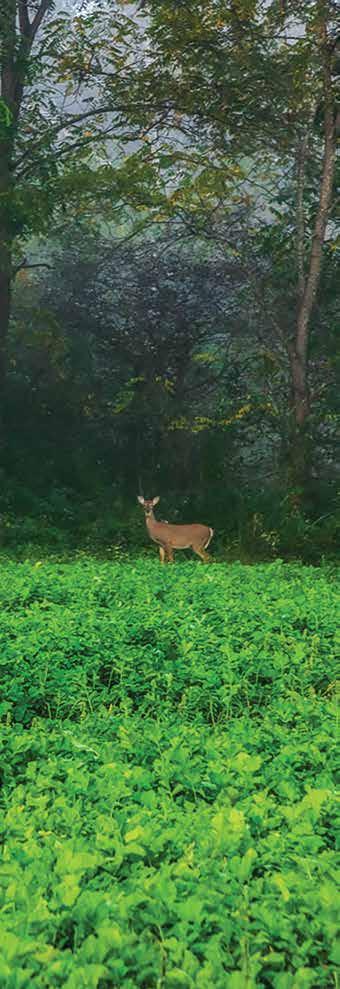
Long Season of Productivity
Although the radishes in Ravish Radish will attract deer immediately, they are even more attractive
Vol. 32-2 | Whitetail News 23
when cold weather and frosts increase the sugar content of the plants. Later in winter, after deer have eaten down most of the green tops, they will continue to feed in radish plots, switching to the large tubers.
How hard deer hit a Ravish Radish plot will depend to some extent on what other foods are available and their stage of palatability or attractiveness. If your Imperial Whitetail Clover or Fusion plots are holding up well, deer might continue to focus on that forage instead of the radishes when they first emerge. Perhaps deer sense that those big-leafed annuals will be taller and sweeter later in fall. But if your clover is struggling a bit from drought or you don’t have enough other summer crops, such as Power Plant, available, deer will turn readily to the young radish plants in August and September, well before the first frosts.
When the radish leaves have been eaten down, deer will feast on the large root in the ground. Digging them up with their hoofs, they’ll dine on tubers during winter, when other foods are scarce, providing crucial energy during a difficult time.
To a point, radish leaves will also grow back after deer munch them down. The best strategy, however, is to plant enough acre age so deer can’t mow down the entire plot. The goal is to have them eat some plants to the ground but have enough others avail able that they don’t obliterate the plot.
Buy the Best
You can buy generic radishes. But why would you want to save a few dollars on seed and sacrifice the chance to grow the best forage possible to attract deer?
Ravish Radish contains the Whitetail Institute’s proprietary WINA 412 Radish, and it’s only found in their product. These radishes were developed through years of painstaking experimentation and are only marginally more expensive than the cheapest bargain-basement seeds. The plants were developed to fit the nutritional needs and taste buds of deer and grow taller, with more tender leaves than cheap generic varieties. They were also tested on wild deer throughout all regions.
Timing
Timing is an important topic when planting radishes. Perhaps more than any other type of food plot forage, radishes and other brassicas need to be planted during a specific time frame. This window of opportunity for the best results ranges from July to Sep-
tember, depending on your geographic location.

Plant radishes too early and they will look good for a while, but the summer heat and long hours of daylight will often make the crops mature and flower or simply wilt and dry out from the heat and lack of rain. Take it from someone who tried this experiment and paid the price; I basically wasted a crop that withered before deer became seriously interested in it, because they had plenty of clover, chicory and Power Plant available. Don’t make my mistake.
On the other hand, don’t wait too long. If you plant too late, the plants won’t have sufficient time to become large and offer the tremendous amount of forage they can produce. This is the lesser mistake, as the plants will still grow and attract deer. But do you want 4-inch leaves or leaves longer than a foot? I know which I prefer.
The researchers at Whitetail Institute carefully test various planting dates and recommend specific ones for each state. In some cases, they even break that down further depending on where you live, as climate can vary from region to region. Follow the guidelines, and plant inside the window of dates. You won’t regret it.
Planting and Managing Radishes
The first step, as with any food plot planting, is to do a soil test and apply fertilizer as needed. Also add lime if required to bring the pH up to at least 6.0. Kill existing vegetation with glyphosate, and then till or disk the ground repeatedly until you get a firm, smooth seedbed. Cultipack or use a weighted fence-type drag to smooth the seedbed. Broadcast the seeds, and cultipack again, or simply spread the seeds and leave them alone if you used a drag to smooth the plot. The seeds are tiny, so barely cover them with 1/8 to ¼ inch of soil. They’ll sprout within days. If rain is predicted, you can simply spread them on top and get good germination. After the plants have reached 4 to 8 inches tall, add about 80 to 100 pounds of nitrogen fertilizer, such as 34-0-0, 43-0-0 or a similar mix per acre to enhance growth and tonnage of forage production.
Mixtures
You can also mix Ravish Radish with other types of plants, such as oats, peas or annual cloversm, and get a terrific food plot. Ravish Radish can also be used as a topper to increase the appeal of an existing plot by adding variety and more additional tonnage of forage.

24 Whitetail News | Vol. 32-2
WHITETAIL RAVISH RADISH ■ Outstanding
late-winter
■
■ Contains
■ Fast
■ Improves
IMPERIAL
early-fall through
attraction.
Available in 2.5 pounds (plants .25 acre).
WINA 412 radish.
germination and emergence, and quick development.
overall soil structure.
“
“RADISHES ALSO PROVIDE OTHER BENEFITS FOR THE LAND AND ENVIRONMENT.”
Additional Benefits

Besides providing high-quality nutrition for deer, radishes have other benefits for the land and environment. One is the ability to aerate the ground and improve the soil, making it better for future plantings. Many plots suffer from hard, compacted soil. Plant roots can’t penetrate deeply enough to obtain sufficient moisture and nutrients to thrive. They are basically living off the first few inches of ground and struggling to spread their roots through the extremely hard dirt below that.
Planting Ravish Radish can dramatically improve that. These plants grow a large, deep taproot that will break up or drill through that hardpan and aerate the soil when the root decays. This allows moisture to penetrate and the roots of future crops to use nutrients farther down in the soil. It also decreases rain runoff and improves soil drainage.
Another feature of radishes is the ability to scavenge nutrients from deep in the soil and leave them at higher, more accessible levels for future crops, reducing fertilizer costs. When the tap root decays in spring, it also adds valuable organic matter to the soil.
According to the USDA, “Radishes provide excellent nitrogen scavenging potential, and the tap roots are excellent at penetrating tillage pans and dense soil layers. An acre of radishes can scavenge 40 pounds or more of residual nitrogen from the soil. The roots help to penetrate and sustain healthy organisms to restore soil structure.”
Ravish Radish offers another benefit for food plotters: weed control. These plants grow so fast with such a large leaf canopy and deep roots that they choke out most unwanted weeds and grasses in a plot, preparing it for a future planting of a different crop the next year. A Michigan study showed that growing radishes reduced weeds by 4,000 pounds per acre compared to fields left fallow.
The USDA also points to another biological benefit of radishes. “An additional special feature of radishes and other brassicas is that they produce compounds called glucosinolates, which are toxic to soil-borne pests and pathogens. Biotoxins produced by brassicas when they decompose are toxic against many pests including insects, nematodes and weeds.”
Radishes are a great high-protein food source, a terrific soil enhancer, a valuable tool for combating weeds and controlling harmful pests. Those qualities make radishes one of the best plants you can turn to for attracting deer and nourishing them through fall and winter.
I know I’ll be putting in several plots of Ravish Radish this year, and hopefully a buck that will top that heavy 9-pointer will decide to pay those plots a visit.
Vol. 32-2 | Whitetail News 25
Anticipation builds as you park the big equipment in the barn and begin praying for rain. Rains come, and the seeds soon germinate and take root. Before long, the brown dirt morphs into a luscious green carpet. “Wildlife will flock to this,” you think, as you anticipate opening day’s arrival. Unfortunately, your trail cameras unveil minimal movement before and during deer season. In a blink, deer season flashes by like a lightning bolt, and the only mature buck that hit your plot during the season was a one-time nightwalker your trail camera captured during the pre-rut. Bummer.
That feels terrible when you’ve invested time, money, blood, sweat and tears into cultivating a beautiful plot. Your lack of return on investment isn’t necessarily because you planted the wrong thing. Perhaps it’s the location you chose. The saying, “If you build it, they will come,” doesn’t always ring true when trying to attract deer with a food plot. Several factors affect how, why and when deer use particular food sources, and they have a common denominator: location.
I’m not an expert wildlife biologist with all the answers. I’m just a deer hunter like you, and through time spent in the woods, I’ve learned a lot about deer tendencies simply by paying attention to details for the past 20 years. I believe you’ll find these points helpful as you prepare to nail down an ideal location for this year’s food plot.

26 Whitetail News | Vol. 32-2
If you’re new to food plotting or your current plot location lacks deer activity, let these parameters guide you in choosing the best location your property offers.
■ by Darron McDougal

Vol. 32-2 | Whitetail News 27
FOOD PLOT LOCATION
AN IDEAL
HOW TO CHOOSE
“
Preliminary Considerations
Of course, the most fundamental aspects to consider when choosing a plot location are prevailing winds and where deer that might use your plot are bedding. In other words, don’t create a situation where you’ll have almost no opportunities to hunt the plot. Try to peg a location mostly downwind (prevailing wind considered) from where deer are bedding. Use a map-based app such as Plot Perfection to reach some conclusions about possible bedding areas on and off your land. You can also walk your land and try to jump deer during spring, but I don’t suggest it during summer or closer to fall, as it could prove detrimental.
Also, positioning a plot too close to a bedding area can be risky, as you might
blow deer out when you arrive to hunt. There isn’t a magic distance, but consider how quietly you can access the stand, and then choose a location accordingly.
Adjacent farming practices should be considered next, as they can hurt or help your cause. If deer must walk through your property to get from a bedding area to large bean, corn or alfalfa fields on other properties, that’s a huge plus. Planting food along their travel routes gives them a reason to stage on your property, and they’ll likely do so during daylight if you minimize pressure. But, if deer don’t have to walk through your property to reach adjacent agriculture, planting a small food plot and hoping it will become a destination is unrealistic. It doesn’t mean you can’t have an effective small food plot. It just means that
you’ll have to temper your expectations, because your property simply doesn’t offer a best-case scenario.
You must also consider potential forest foods that can compete with your plot, and their location. In areas with oaks, the acorn drop can greatly affect deer activity around your plot. If your plot isn’t near oaks, expect deer activity to plummet when acorns fall, as deer prefer to feed in the timber, not in the open, for security. If you can add a food plot where oaks or other mast-producing trees exist, though, your food plot will likely remain active.
Another preliminary consideration is soil quality. You can improve soil quality through lime and fertilization, but if you have varied soil types on your property, you might consider choosing a good location that also provides optimal soil that requires less preparation.
To summarize, you must understand where deer bed, the prevailing wind direction, adjacent farming practices and how they facilitate deer movement, and naturally occurring forest foods and how they will affect your plot location during deer season. Then, evaluate soil pH before moving forward. Not all properties are created equal, but these considerations will guide you in doing the best you can with what you have.
Existing Clearings
You do not have to level trees and dig out stumps. Do not work harder than you must. If an existing clearing is ideally located based on critical criteria, cultivate your plot there.
If an area lacks trees for a stand (talking specifically about bowhunting), that might hinder you from planting a plot at an existing opening. Maybe it is solid ground that abuts a cattail slough or a wide-open CRP field with tall grass for bedding. Do not let a lack of trees stop you. Instead, get creative with your ambush. Brush in a ground blind well before the season, or haul in an enclosed

28 Whitetail News | Vol. 32-2
“UNDERSTAND WHERE DEER BED, THE PREVAILING WIND DIRECTION, ADJACENT FARMING PRACTICES AND HOW THEY FACILITATE DEER MOVEMENT, AND NATURALLY OCCURRING FOREST FOODS AND HOW THEY WILL AFFECT YOUR PLOT LOCATION.”
elevated blind. Do not pass up great locations for silly reasons. Simply adapt.
Size should not govern your decision to plant or not plant an existing opening. If the opening is small — one-eighth of an acre or smaller — don’t overlook it. Again, we’re talking about choosing an ideal location, and a small plot at a great location can be better than a big plot in a poor location. Plus, be attentive to opportunities to enlarge that opening to plant more food.

If your property is amidst large timber with no agriculture, an existing opening — large or small — planted in Imperial Whitetail Clover or Fusion could become choice dining for many local deer. It might take a season or two for them to really make it their own, but with no competing agriculture in the area, even a small plot in the big timber can become dynamite.
Of course, don’t try to force a plot into an existing opening if it’s at a poor location. In that case, call in the big equipment, and create a new opening at a better spot.
Create a New Clearing

Creating a new clearing is exciting and can give you the latitude to put food where it counts. But much forethought should go into this. Big habitat changes are semi-permanent. That can be a good thing, but it can be horrible if you’re off the mark. In other words, you can’t hit the undo button and start again after the clearing is done. What you’ve done will alter
deer movements for better or for worse, and you’ll have to live with it for many seasons. So, plan wisely before you fire up the chainsaw and skid steer.




Final Thoughts
Always remember your plot’s purpose. On large parcels, you might have destination food sources that aren’t intended for hunting and also smaller sub-plots at staging areas between bedding and destination food sources. If you’re on a 40-acre parcel, you might have only one or two plots intended for hunting. The plot’s purpose helps you define a good location.



Also, consider what type of hunting your plots are intended for, as that also pertains to location. If your plot is for archery hunting, you’ll want to lay it out so most, if not all, deer that come to feed will enter within easy archery range. In contrast, a long, linear plot can be excellent for a rifle hunter. Not all locations can be crafted to those dimensions, so choose the location that best allows you to craft the plot for your hunting application.

Every property is unique, and there isn’t a one-size-fits-all location for the best food plot. You’ll need to consider the points we’ve discussed and then apply common sense as you select plot locations. If you do that, you’ll probably orchestrate a more productive hunting season than the one in my opening paragraph.

ENRICH Your Land Planting soft and hard mast orchards is a great way to significantly increase available wildlife nutrition for an extended period of time. As the industry’s leading nursery, Chestnut Hill Outdoors is the trusted provider to help you reach your land stewardship goals. chestnuthilloutdoors@gmail.com · 855.386.7826 CHESTNUTHILLOUTDOORS.COM SouthernCrabapple 3-Gallon chestnuthilloutdoors@gmail.com 855.386 7826 CHESTNUTHILLOUTDOORS COM che tnuthilloutdoors@gmail.com 855.386 7826 CHESTNUTHILLOUTDOORS COM DeerMagnet Persimmon-LateDrop chestnuthilloutdoors@g 855.386.7826 CHESTNUTHILLOUTDOORSCO Collection 7-Gallon chest uthilloutdoors@gmail.c m 855.386 7826 CHESTNUTHILLOUTDOORS COM Total Graphic Area: 3.05” x 6.5” Total Visual Area: 2.8” x 6.3” -Background color/images must bleed to the edge of artboardDunstan Chestnut 7-Gallon he t thilloutdo s@g ail.c 855.386 7826 CHE S TN U TH L L O UT DOO R S C O M
FIND YOUR PATH
Put one foot in front of the other along good entry and exit routes this season.
 ■ by Josh Honeycutt
■ by Josh Honeycutt
30 Whitetail News | Vol. 32-2
■ Hunters who use effective entry and exit routes fill more deer tags. Shielding your approach from bedded deer is important when trying to reach blinds and tree stands undetected.

Cloudy skies blanketed the landscape with melancholy repose. The world seemed lifeless, but it wasn’t. Those hills were full of whitetails. But my destination was a tree stand at the fringe of a bedding area commonly used by a gross Boone & Crockett buck.I’d been hunting the giant for two seasons and believed I was no closer to filling that tag than the day I first captured a trail camera photo of him. Even so, I slowly ascended the steep hillside, silently reassuring myself this would be the day I arrowed that elusive 185-inch buck. But my brow brimmed heavy with sweat, and doubt surpassed my confidence. Each step was a blow to morale, as I’d experienced what was to come too many times before.
Despite extensive efforts to take different routes, I still had no solution for the open area surrounding the only stand location where my target buck often appeared on camera during daylight. I knew he was bedding nearby, but I couldn’t close the final 75 yards to the stand without bumping him or other deer that would then spook him. I’d already watched the buck dash away twice. A few yards later, it became thrice.
I never killed that deer, but if I’d deployed some of the options listed below, I might have. So don’t be like me. Instead, plan and use solutions for bad entry and exit routes.
Vol. 32-2 | Whitetail News 31
Good Entry and Exit Routes Defined
First, realize that a stand location is only as good as the entry and exit routes to and from it. If you can’t get to a stand without bumping a target deer, it’s good for zero hunts. If you can get there but can’t get back to the truck without spooking deer, it’s good for only one sit.
Of course, if deer see, hear or smell you, the gig is up. Good entry and exit routes solve those problems and keep hunters off the radar of whitetails. That requires an understanding of how winds flow throughout the property, the location of bedding areas and more.
Bad Entry and Exit Routes Defined
In contrast, bad entry and exit routes spook deer when you use them. They bring you too close to deer, don’t shield you visually, don’t help audibly and might carry you upwind of deer. This creates an immediate negative effect.
Bad entry and exit routes also have the potential to spook deer long after you’re gone. The scent left behind lasts for hours, and if you’re taking a path that crosses commonly used deer trails, it’s certainly having a negative effect, even if you don’t realize it.

Solutions for Bad Entry and Exit Routes
Fortunately, hunters can take many steps to remedy entry and exit route issues. Some require manipulating the landscape. Others don’t. But all have their place.
Choose a new route: Some entry and exit routes can’t be fixed, especially if the primary issue is wind direction. There’s no solution for that other than to wait for a better wind. If that doesn’t solve the issue, the best thing you can do is simply choose a new route.
Walk ditches and drainages: Surefire effective routes include ditches and drainages. These are good for several reasons. First, if deep enough, these conceal your profile, which prevents deer from seeing you. If narrow enough, they can be almost void of deer traffic, which means deer shouldn’t pick up your ground scent. And third, if they’re sufficiently sandy or damp, your footsteps
IMPERIAL WHITETAIL CONCEAL

Conceal can satisfy many screen-related tasks. It can create bedding cover, cover for travel routes or plot perimeter screens. It can connect islands of cover, divide food plot areas, shield properties from roadways, add cover around stands and blinds and more. Conceal produces the best growth when planted properly, and planting dates are important. People in far northern latitudes should plant May 20 to June 30. Central latitudes should plant May 1 to June 30. Southern latitudes should plant April 1 to May 31. Conceal is available in a 7-pound bag for $35.98 or a 28-pound bag for $119.98.
■ Strategic planting.
■ Available in 7 pounds (plants .25 acre).
■ Designed to create thick cover, screens,
can be almost noise-free.
Wade shallow creeks and streams: If they’re shallow enough to safely wade with rubber boots, creeks and streams are good for the same reasons as drainages and ditches. These offer visual-, audible- and scent-based advantages. Further, if you remain in the creek along the entry or exit route, it can reduce ground scent to almost nothing.
Follow ridge lines: Ridge lines are another terrain feature that can double as an entry or exit route shield. During the right circumstances, walking along the back side of a ridge, and then easing over the top into position, can help you slip into blinds and stands unnoticed. That said, if you must walk through too many deer to get there, it might not pan out.
Use standing corn: I don’t advise planting corn as an entry or exit route screen. The goal is to hide hunters from deer — not to attract them to something that’s supposed to hide you. Further, farmers will likely harvest corn in September or October, making it an unreliable option.

Cut trails through cover: Folks who have a lot of heavy cover deer don’t use as bedding areas should consider cutting access trails through those areas. These can serve as excellent routes to and from tree stands and ground blinds.
Hinge-cut trees: Land managers with a lot of low-odds, hard-to-reach stand locations might consider hinge-cutting trees along these paths. Follow safety protocols, and use safe hinge-cutting practices.
Plant a screen: The best fix for a bad entry route is best solved with a seed. In tillable areas, Whitetail Institute Conceal is the premier option for food plot screens. It’s a fast-growing cover that offers the necessary visual shield to create quality entry and exit routes. This annual grows 5 to 8 feet tall, sometimes taller, and creates a great visual buffer. Fortunately, Conceal is not a food producing plant and won’t attract deer from other forage.
Going the Distance
Regardless of the solution that’s right for you, you can do other things to minimize the risk of deer seeing or hearing
32 Whitetail News | Vol. 32-2






■ Flexible, detailed journal allowing food plotters to keep historical and current information about all their food plots ■ Seamless way for users to track food plot work, results, and trends over time ■ Outstanding planning tool for future food-plot tasks ■ Everything from integrated mapping to soil amendment and seeding information ■ Connected to our Whitetail Institute laboratories for easy submittal of soil tests ■ Soil test results appear in Plot Perfection ■ One stop shop for all your food plotting needs and a first of its kind app SUBSCRIBE TODAY! Receive 2 Downloadable Soil Tests FREE value of $23.90 OFFER GOOD UNTIL 9/30/22 Visit https://plotperfection.com today or call 1-800-688-3030, and begin building your food plot journal. WATCH TUTORIAL VIDEO HERE: Subscribe TODAY at www.PlotPerfection.com
SIGNS OF A BAD TREE STAND LOCATION

•You’ve determined the difference between a good entry and exit route.
But it’s equally important to understand the signs of a bad tree stand location, including:
1. Poor entry routes (spooks deer before a hunt).
2. Bad exit routes (spooks deer after a hunt).
3. Limb cover is too thick (prevents shot opportunities).
4. Limb cover is too thin (offers too little visual cover).
5. Tree trunk is too big (dangerous to hang tree stands in).
6. Tree trunk is too small (dangerous and offers too little back cover).
7. Tree trunk is leaning (dangerous to hang tree stands in and decreases comfort).
8. The stand location is skylit (offers too little back cover).
9. Primary action is too far away (deer tend to skirt by out of range).
10. Primary action is too close (deer tend to see or hear you more easily).
you along entry and exit routes. First, move slowly. Hunters often walk too fast, make too much noise and spook too many deer. Moving slower and taking longer pauses can reduce your visual and audible impact on nearby deer. You might also see or hear deer along the route before they see you.
Further, wearing quiet clothing material, such as fleece, reduces noise when you brush against foliage. Wearing qui-
et footwear, such as moccasins or other soft-bottom shoes, helps minimize noise, too. In contrast, rubber boots are louder, but can leave behind less scent.
Another important task is to lose the light. Deer can see beams of white light, and they don’t react favorably. On private land, where other hunters aren’t present, and where there aren’t terrain-based or other safety risks — such as cliff or sinkholes — the moon often
offers enough navigable light during pre-dawn and post-dusk treks.
No matter the protocols you enact, it takes dedication, effort and skill to go the distance. Find your path this season. Locate or create the best possible entry and exit routes on your properties.
34 Whitetail News | Vol. 32-2
“A STAND LOCATION IS ONLY AS GOOD AS THE ENTRY AND EXIT ROUTES TO AND FROM IT.”
“
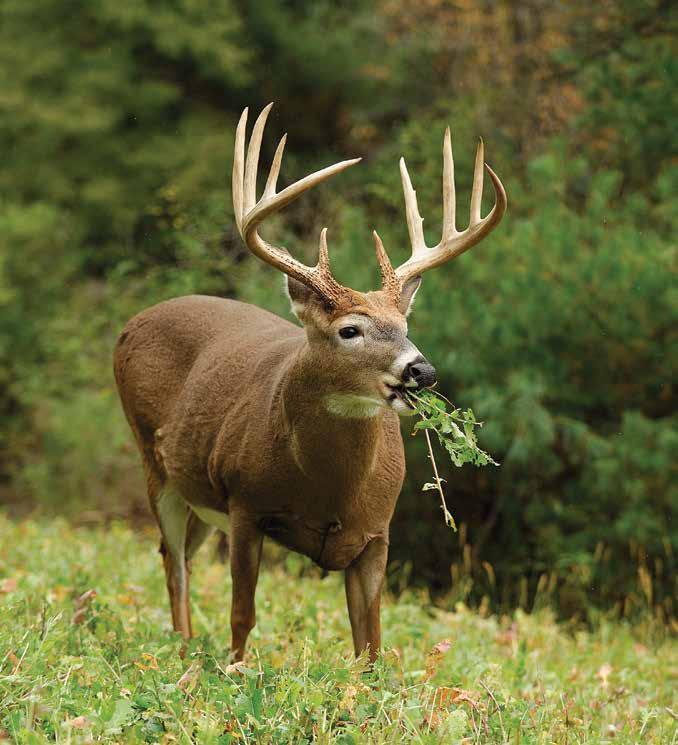











Whitetail Institute annuals produce high-protein tonnage for antler growth, unmatched attraction during the hunting season and sustained production in winter months. Each annual is expertly developed to match your specific needs. Includes seeds only available in Whitetail Institute products. Still the leader since 1988 IMPERIAL WHITETAIL ANNUALS RESEARCH EQUALS RESULTS WHITETAIL INSTITUTE 239 Whitetail Trail, Pintlala, AL 36043 • 800-688-3030 • www.whitetailinstitute.com
Land managers can take several steps to help deer survive the frigid lean season.


WINTER
36 Whitetail News | Vol. 32-2
■ Text and Photo by Matt Harper
“
I’m not a big fan of winter. Some folks love the snow and cold, as it provides a platform for adventures like skiing, snowmobiling, sledding, ice-fishing and snowball fights. Then, of course, there’s the beauty of a winter landscape of crystalline, glistening vistas created by wind and snow.
I get that, and I suppose if you’re playing outside or sitting inside enjoying the view next to a warm fire, winter can be enjoyable. But for me, winter means checking cows in bone-numbing temperatures, tractors and trucks that won’t start, cattle waterers that are frozen, and everything being brittle, prone to breaking and constantly getting stuck in deep snow. There are things I like about winter, such as the colder temperatures needed for good bowhunting and even colder temperatures and snow attracting deer to food sources for late-season hunts. When that’s finished, however, and tags and freezers are filled, you’re left with the snow and cold. Maybe that’s why I don’t like winter. It’s a brash, harsh reminder that I have a year to wait for another deer season.
In Iowa, we can hunt deer through early January, with the late muzzleloader season ending about Jan. 10. Then it’s time to take down ground blinds and trail cameras (I actually wait a couple of weeks to see which bucks made it through season) and pack away the accouterments of deer hunting. Then you enter what I call a whitetail hunter’s purgatory: several weeks when you wander aimlessly, lost without your hunting north star. It’s too early to plant food plots, and mineral sites are covered with snow. You could scout, but do you really want to do that in snow and cold? That can be done in a couple of months, when you’re out shed hunting. So essentially, it seems everything deer-related stops. But as you sit inside, warm, comfortable and waiting for the snow to melt, there’s a life-and-death struggle to survive outside in the deer world.
The Hardest Part of the Cycle
A deer’s life is a continuous cycle revolving around survival and perpetuating the species. Spring and summer are typically the months of plenty, when food sources are at their peak. A new generation of fawns is being born and raised to strengthen the herd ranks. Bucks are living the bachelor life, done with fighting, and content to hang out together and leisurely prepare for fall. Autumn marks the season of beginning, at least from the perspective of proliferating the species, and it’s
filled with action and intensity, as the theater of the rut rolls back its curtain for another riveting performance. And then there’s winter, which often goes unnoticed by deer hunters, as our interests turn in other directions. Sure, we might see deer grouped in a snow-covered cornfield or huddled in a thick patch of evergreens, trying to avoid an icy north wind. But short of being glad there are still deer around, we pay far less attention than we would if the calendar were flipped to August or September. Even bucks are largely unidentifiable, as their physical profile is not dissimilar to that of their female counterparts. So it’s understandable why deer move to the back burner of our sporting consciousness, replaced by considerations about new turkey calls, restringing a favorite reel or maybe dusting off the golf clubs. But in truth, winter is one of the most critical times for deer management, as it’s a period with one of the highest death rates. Ice, snow, cold temperatures and a diminishing food supply kill many weaker animals. But weakness does not necessarily just affect the old, sick or young, as you might expect. Severe winters can also take some of your best bucks.
Winter and Death Loss
When most people think of deer succumbing to winter, the first thought is that cold temperatures are the main culprit. After all, on a cold February night when temperatures dip below zero, it’s difficult to imagine how anything could survive. And severe cold can contribute to winter kill. But deer are pretty well adapted to cold weather, especially where cold temperatures are normal for winter.
Deer undergo a molt during which they completely change their hair coat to one best suited for a season’s temperatures. During summer, deer sport a hair coat that’s dense and consists of solid-cored hair. This hair type helps to keep the animals cooler in spring and summer. When temperatures begin to cool and summer rolls into fall, deer trade their summer hair coat for the winter version. Winter hair is hollow and provides much greater insulating ability to aid in maintaining thermal homeostasis. If you have seen deer bedded during a snowfall, you’ll notice the snow doesn’t melt off their body, which shows the ability of the hair to insulate the internal heat deer produce to maintain body temperature. Again, I’m not saying cold doesn’t play a part in the death of some deer, but other factors are more detrimental.
Vol. 32-2 | Whitetail News 37
“WEAKNESS DOES NOT NECESSARILY JUST AFFECT THE OLD, SICK OR YOUNG. SEVERE WINTERS CAN TAKE SOME OF YOUR BEST BUCKS.”
THE LAY OF THE LAND IN THE PALM OF YOUR HAND.

DESIGNED TO TRANSFORM THE WAY YOU HUNT BY DELIVERING IMAGES AND INSIGHTS DIRECTLY TO YOU, the Moultrie Mobile System is the ultimate scouting tool. With the reliable BASE cell cam and the intuitive Moultrie Mobile app – featuring weather data, activity charting, species recognition and interactive mapping, the Moultrie Mobile system gives you control over your hunt in the palm of your hand.

Get to know all of the easy-to-use features of the Moultrie Mobile ® system by visiting our website. And DOWNLOAD THE APP TO D EMO FOR FREE.







ACTIVITY CHARTING REMOTE SETTINGS SPECIES RECOGNITION WEATHER DATA INTERACTIVE MAPS IMAGE GALLERY WEATHER DATA ACTIVITY CHARTING

MOULTRIEMOBILE.COM
Wind and ice can challenge thermal homeostasis more than cold temperatures. Freezing rain and cold mud at 25 to 30 degrees can be harder on an animal than 0 degrees with no wind and sunshine. Wind and moisture dissipate the core heat of warm-blooded animals more quickly.


But a bigger contributing factor to winter kill is probably the lack of quality chow and the quantity of food. It takes energy for a deer’s body to generate heat to stay alive and move through deep snow cover. Winter presents ever-diminishing food and a consistent decline in food quality as the cold months pass. Liken it to you stocking


your pantry in spring and summer to have enough supplies for fall and winter. And imagine your pantry is a mile from your house. Early in winter, you have plenty of food, and it’s an easy walk to get there and back. As winter drags along, with colder temperatures and ever-increasing snow, your pantry starts to run low, and you burn more energy trudging through the cold drifts to get your food. Remember, you can’t simply go to the store to restock your pantry, so when the food is gone, it’s gone. You must wait for spring for any chance to rebuild your food supply. That’s what deer deal with in addition to avoiding predators, which requires
even more energy.
Quality food is relatively abundant in fall and even early winter, but when plants and bushes stop growing, and hard and soft mast has been produced, there will be no more food provided until spring. Deer must live on whatever food sources are available. By late winter, food has decreased, along with the quality of those sources. Deer have scavenged every picked crop field, acorn flat or bushy browse they can find. They have a protection mechanism to help them maintain an energy balance of usage and consumption, which is essentially a form of hibernation. They don’t den up like bears, but their metabolism slows, resulting in a decreased demand for food. Even in captivity, where deer are offered all the food they can eat, their intake often decreases during winter. But that doesn’t mean they can go without eating, and starvation is still the most likely contributor to death. The greatest cause of winter kill is the combination of harsh elements combined with a lack of food.
Who Dies?


First-year fawns make up a significant percentage of winter kill. They are smaller, and moving in deep snow is more difficult for them, which can lead to a downward weakness spiral. Their smaller size also makes them more susceptible to heat loss. The larger the animal, the greater the ability to maintain core body temperature, because of less surface area compared to mass. Deer that are injured, sick or old will also be susceptible to winter kill. But as mentioned, even bucks you were chasing in November, which were in the prime of life and appeared as strong as an Angus bull, are often the victim of the winter reaper.
During the rut, bucks burn a tremendous amount of energy while seeking, chasing, fighting and breeding. They are constantly on the move, eating little and burning the fat stores they built up in spring through early fall. They can lose 25 percent or more of their body weight, leaving them a shadow of what they were in September. When rut winds down, winter is at the doorstep, and bucks eat all they can to rebuild the fat stores desperately needed for winter.
40 Whitetail News | Vol. 32-2
IMPERIAL WHITETAIL OATS PLUS ■ Early- and late-season attraction. ■ Available in 45 pounds (plants .5 acre). Proprietary high sugar oat mix. IMPERIAL WHITETAIL POWERPLANT ■ Available in 25 pounds (plants .75 to 1 acre). ■ Spring and summer annual. ■ Produces
tons
nutritious
Contains
and
several
of highly attractive, highly
forage even during summer.
forage beans, peas, sunflowers
sunn hemp.
If good quantities of high-quality food are available, bucks can pack back on some winter life support. But if not, or if winter hits early and excessively hard, bucks can go into winter weaker than a 2-year-old doe. Actually a 2-year-old buck will likely have a better chance of surviving than a 4- to 5-yearold buck. An older buck will likely rut longer and harder than a younger buck, expending more of what they need to make it through winter. You can find evidence of how much body condition can decrease in a mature buck by comparing the carcass of an early bowkilled buck versus a late-season buck. The early bow buck will have thick fat along its back, but a late-season buck might have nothing more skin, muscle, and bone.
What Can You Do About It?
You can’t stop cold winter weather or determine how long it sticks around, other than moving to southern Florida. But you probably can’t take the deer herd with you. You can, however, do some things to help with the elements — specifically wind. Certain types of trees and bushes can offer increased thermal protection. In southern Iowa, we have red cedars, which are considered a weed by most people, especially farmers. They spread like weeds, and in a few years can completely take over a pasture or field, damaging the soil and crowding out other plant species while providing little to no food for wildlife. It would seem eradication would be the appropriate management practice, and if you’re focused only on food, it would be. But cedars provide excellent thermal protection. Even in the dead of winter, they retain their needles and can block icy winds, especially in large clumps or patches. Therefore, some cedars on a property will go a long way to help protect deer and other wildlife from winter’s cruelty. In other parts of the country, other plant, bush or tree species can provide thermal protection.
The second management tactic for helping deer survive winter is to provide them as much food as possible, and it must be the right kind of food. Remember, after frost hits, plants stop growing, and whatever food is pro-

duced is what’s available for winter. Planning for that begins long before the first day of sweatshirt weather. In fact, you should plan and plant winter food sources during spring and summer.
First, it’s important to have adequate amounts of high-quality food in the spring, summer and early fall for deer to enter winter in good condition. When bucks enter the rut in better condition, they’ll be less run down afterward. The more food available right after the rut, the better chance bucks have to restore body condition. To accomplish that, I make sure deer have a high-producing perennial, such as Imperial Whitetail Clover, which produces tons of high-quality, highly nutritive food. That’s in combination with selected annuals that provide food in late summer and early fall, such as Imperial Power Plant and Whitetail Forage Oats.
Next, I focus on the food that will be available to deer when snow starts to build up. Brassicas are a good choice to fill that need, as they tend to produce lots of tonnage that sticks above the snow or can be dug up by deer. Further, brassicas are typically high in energy-supplying carbohydrates. Tuber varieties such as turnips provide a food source deer can extract and consume. In terms of quantity, more is better. Remember, whatever is there is finite, and more won’t miraculously grow during the depths of winter.
If you want to nerd out on your food plot management scheme, estimate the total number of deer on your property, come up with a consumption level and calculate what you think the total pounds or tons of food consumed will be during winter. For example, if you think you have 30 deer on the property, their average weight is 170 pounds per animal and that deer will eat 3 percent of their body weight per day (it’s actually probably less in winter, but that will help to overestimate), you can calculate food requirements. Each deer will eat about 5 pounds per day. Multiplied by 30 deer, that’s 150 pounds per day. Say you want to provide winter food from December through March, which is 121 days. Multiply 150 pounds by 121 days, which gives you 18,150 pounds required. If your food plot pro-
duces 3 tons of winter forage per acre, you need to plant about 3 acres to meet that need. We’re dealing with estimates, not exact figures, to use as a guideline. Deer might consume less per day than the figures in that formula, and there might be food sources other than the food plot. The key is that something is better than nothing, and anything you can produce to provide food during winter will help to improve survival.
IMPERIAL WHITETAIL
CLOVER
■ Perennial three- to five-year longevity.
■ Available in 2 pounds (plants .25 acre), 4 pounds (plants .5 acre) and 18 pounds (plants 2.25 acres).
■ Genetically selected specifically for deer. For soils that hold moisture.


Vol. 32-2 | Whitetail News 41



















































































IMPERIAL WHITETAIL Perennials RESULTS RESEARCH EQUALS WHITETAIL INSTITUTE 239 Whitetail Trail, Pintlala, AL 36043 • 800-688-3030 • www.whitetailinstitute.com
Scienti cally designed to attract and grow bigger deer. Includes proprietary seeds developed by Whitetail Institute agronomists. Designed to last up to ve years from a single planting. Still the leader since 1988
MANAGEMENT PRACTICES:
THINGS HAVE CHANGED
Successful food plotting involves many more considerations than early efforts decades ago. But as modern land managers know, the work is well worth it.
 Almy
Almy
Dawn was just a faint orange promise in the east when I saw the first forms of deer in the Winter-Greens plot. Slowly raising my binoculars, I began scrutinizing them carefully through the 8X optics. Doe, doe, doe — buck.
Not only a buck, but a nice deer I’d had my eyes on, with a tall narrow rack that almost joined at the main beam tips. Shifting the crossbow slightly, I centered my scope just behind his shoulder blade and squeezed the trigger. The sharp snap of the bow string and scattering deer
knocked any morning sleepiness out of me. I watched as the buck faltered, ran hard and then seemed to go down just inside a patch of woods bordering the plot.
After waiting a half-hour to be safe, I walked toward where the deer had disappeared and found a bright red blood trail. Minutes later, I wrapped my fingers around a fine Virginia buck.
That hunt was partly the product of luck. But like so many things in life, it was also a reward for lots of hard work. In that case, the work started with extensive re-
Vol. 32-2 | Whitetail News 43
■ Text and Photos by Gerald
■ The author mows an Imperial Whitetail Clover field. Even small plots will attract whitetails if they are high quality and maintained well.
search about the best food plots for deer on my land. It then involved preparing the site, not cutting corners, purchasing the best seeds and following all the steps required to produce a high-quality field of forage that would attract bucks.
People who don’t grow food plots or are new to the game sometimes think you can just toss out some seed and produce a lush, nutritious food plot that will attract deer like a magnet. In times past, that might have worked. Well, sort of. The plots were green, anyway. And they attracted some deer. But nutritious? Not very. Lush? Not too often.
And frankly, the only reason that simple approach worked was because those old-timers were among the few people offering anything for deer.
But tossing out a bit of rye or wheat will not likely pay dividends in 2022. Food plotting has become highly sophisticated, with land managers dedicating extensive time, effort and finances to create the best plots for whitetails. The plot I grew, and most of the best ones across the country, involve much more than tossing out some seed.
They don’t involve backbreaking work and an inordinate amount of time. But they require a bit more than the earliest food plot pioneers put into their efforts. And most important, it involves more informed effort. That translates into many things, including using the high-

est-quality seed, made available by years of research and development by university agronomists and private companies that pioneered the science of creating new and improved deer forages, foremost among them the Whitetail Institute of North America.
The Modern Scene
The plot that attracted the buck at the beginning of this article was not the product of throwing a bit of seed out and waiting for rain. It involved carefully selecting the best site for growth of the forage and monitoring the sunlight at the plot to make sure it was sufficient for the planting. It involved choosing the best forage blend after careful thought about the pros and cons of each prospective plant type for the location and soil variety. It involved making sure the site was weed-free, with herbicide treatments and multiple passes with a tiller.
I also sampled the ground, taking soil tests at several spots to see what nutrients were needed. Sure, I could have thrown out some 10-10-10 and the plot likely would have done OK. But the soil test revealed exactly what proportions of nitrogen, phosphate and potash were needed for the best growth. The pH, or acidity, of the soil was also detailed in the sample, letting me amend it with the right amount of lime to bring it to a level that would provide maximum forage
growth.
After the perennial plot was thriving, I addressed competing weeds by mowing at the right growth stage and weather conditions to clip off seed heads and reduce the volume of weeds. That step also stimulated the growth of new, more tender and nutritious foliage. No broadleaf weeds threatened the plot, but several competing grasses were, even after mowing, so it required treatment with Arrest Max.
Was it worth the fuss? I believed so when I wrapped my hands around that crossbow buck. And to be honest, the effort involved was not work for this habitat manager and whitetail hunter. To the contrary, it was a fun and engaging hobby. Like most outdoorsmen and food plotters, I enjoy the many facets of this pursuit. And like many endeavors, the more you put into it, the more you get out of it.
In the old days, with few people growing forage for deer, food plotting meant spreading some rye or wheat out in late summer or early fall to create a green field. It was also often sown for cattle, so the needs of livestock were paramount, with deer in many cases an afterthought. Whitetails came to those ag fields and smaller, haphazardly planted plots, which offered an oasis of food compared to the surrounding stands of open, mature timber. And hunters killed some
44 Whitetail News | Vol. 32-2
■ The author gets ready to put in Power Plant.





Imperial
Clover provides attraction and up to 35% protein levels. These proprietary clovers were developed by
agronomists. Still the leader since 1988 IMPERIAL WHITETAIL CLOVER WHITETAIL INSTITUTE 239 Whitetail Trail, Pintlala, AL 36043 • 800-688-3030 • www.whitetailinstitute.com
Whitetail
Whitetail Institute
nice bucks on them.
But as the title to this piece says, things have changed. In the three-plus decades since Ray Scott introduced the first version of Imperial Whitetail Clover, food plotting has developed dramatically, with multiple companies offering various seed blends to attract deer. (Many of those products from competitors are mostly just re-bagged generic seeds, but that’s another story.)
Hunters have learned that to attract bucks, they’d better step up and plant the best products available. They’ve learned that if they don’t provide the most palatable and nutritious offerings, deer might camp out at a neighbor’s property with better forage, more food, greater variety or food that lasts longer.
Rather than just trying to attract animals during hunting season, as was done in the past, today’s food plotters realize that to hold whitetails and let them reach older ages, they must provide forage all year. A deer can’t stop eating except in fall, when most people used to put plots out. A buck can eat natural foods at other times, but many of them are of poor nutritional quality during midsummer and late winter.
A food plotter who offers the best forages during those difficult times, even when hunting isn’t open, will attract more deer and also likely lure in mature bucks. If deer have food available 365 days per year on one tract and not another, guess where they will make their home?
In the past, food plotting decisions were simple: rye, oats or wheat? Today’s hunter/land manager has a vastly wider selection of forages for various soil types, times of year, locations and goals.
Yes, things have changed. There is, whether we like it, competition to attract deer. Better plants and smarter effort create the plots that attract deer best.
Today’s Steps
To grow the best plots possible, you must take several steps, as mentioned. First, consider your soil type. It might be rich bottomland or drier upland. It might have balanced pH or be acidic. Or you might have various types of soil at various parts of your property. Each needs to be approached as a unique sit-
uation. Whitetail Institute has lots of helpful material at whitetailinstitute. com to help you decide what plantings might be optimum for each soil type. And its staff will offer all the help they can with phone consultations.
After you’ve settled on a forage for a specific site, conduct a soil test, which is the best way to determine what you should do to amend it with nutrients such as nitrogen, phosphorous and potassium. This will also tell you whether you need lime to boost the pH into a less acidic range, preferably 6.5 to 7. If pH is extremely low, the Institute has special-purpose seed mixtures for challenging conditions, such as Extreme and Edge, which will thrive in lower-quality soil.
These steps were seldom taken in the old days. But if you want the best plots in 2022, you’d best up your game and get the soil to its maximum potential before beginning to plant.
While you’re preparing to add lime and fertilizer, you can begin thoroughly removing unwanted vegetation with non-specific herbicides and several tilling sessions. Add the lime as early as possible during the tilling or disking process so it has sufficient time to reduce the acidity. Try to bring it up to 6.5 or higher. The fertilizer, on the other hand, is most helpful when applied soon before planting and worked in with the last pass of the tiller. The final step involves carefully adding the right amount of seed, planting it to the exact depth recommended and doing so during the proper time for the forage and your location.
After they mature, some forages don’t require additional maintenance. Perennials, however, such as Imperial Whitetail Clover and Alfa-Rack Plus, often benefit from mowing once or several times per season. Some landowners skip those maintenance steps. And they pay the price with less attractive plots, more weeds and fewer deer.
Cutting should be done when the weather is not too hot or dry. And it needs to be done when the weeds are slightly higher than the forage. By nipping the seed heads off, you can reduce the weed and grass growth dramatically. Cutting some of the flowering perenni-
al tops also stimulates fresh, tender and more nutritious plants to regrow.
Weeds might be controlled sufficiently in that manner, but extra spraying with selective herbicides such as Arrest Max, to reduce competing grasses, and Slay, to tackle competitive broadleaf weeds, is often required. Old timers might scoff at that effort. But today, most hunters/land managers don’t mind the extra work. It’s part of the game — the greatest hobby I know.
Another new addition involves planting tall annuals, such as Conceal, leading to plots and sometimes right into them. The goal is to make deer, especially mature bucks, feel more secure approaching the forage. You can also create access routes to the plot with shields or strips of these sorghums, letting you slip in without being detected. Deer are hunted far more intensely than in the old days, so anything that makes them feel more secure using a feeding site is helpful.
Conclusion
Many other management practices have changed. Adding water sources, bedding cover, transition corridors, staging areas and fruit trees are beneficial projects that will make your food plots attract and hold deer. We’ve learned that creating a sanctuary that’s never hunted is also important. Having an area mature bucks can go when they feel pressured gives them a feeling of security and encourages them to stay at your property.
When you combine those extras with the best food plot forages, you will have done everything to improve the quality of the deer herd and increase the odds of holding them on your land.
Yes, things have changed, like they do in almost every aspect of life. I used to love pecking out articles on my IBM Selectric. But you won’t catch me writing with one today. Not all changes are good, but the development of efficient desktop personal computers is one I’ll embrace. And using high-quality food plot forages created especially for whitetails instead of generic seeds meant for cattle is one I’ll also embrace.
46 Whitetail News | Vol. 32-2





Impact is the next generation soil amendment that releases nutrients and feeds forages in lower pH soils. Turn poor soil or hard to access plots into productive food plots. Still the leader since 1988 WHITETAIL INSTITUTE IMPACT WHITETAIL INSTITUTE 239 Whitetail Trail, Pintlala, AL 36043 • 800-688-3030 • www.whitetailinstitute.com
Tree species identification is important for many reasons, but none more so than whitetail preference. Deer almost always target white oak acorns rather than red oak species. This is entirely because of taste. Acorns have varying levels of tannin (tannic acid), within the nut. White oaks tend to have much lower levels than red oaks, which translates to a sweeter taste in the former and a more bitter offering in the latter. Because of that wide range in tannin, whitetails clean up dropped white oak acorns within days, whereas it can be weeks or months before they consume all red oak acorns.
Another reason to know your oaks is mast production frequency. You need to time the mast crop drop. White oak trees take one year to mature and produce a ready-to-drop acorn. Red oak trees require two years to do so. Knowing where these trees are on your hunting property and what year they’ll likely drop acorns can help you make better hunting decisions. Keep a log of this to predict future deer movements.
Finally, if you manage land, planting oak trees is important. Acorns are low in protein (about 6 to 8 percent) and aren’t what deer need in spring and summer. However, they are high in carbs (about 40 to 45 percent) and fats (about 50 to 55 percent), which is what deer need through fall and winter. Understanding the nutritional value of oaks, where various species thrive and the timing of their mast crop drop are important factors.

Oak Tree Identification
Oak tree species fall into one of two fam ilies, including red and white oaks. These can be identified in four ways. Study the leaf, bark, acorn and tree location to help determine the species.
Leaves: Generally, white oak species have leaves with rounded lobes without spines at the tips. In contrast, red oak species have leaves with more pointed lobes with spines near the tips. You’ll notice a stark difference between these.
Bark: In most cases, white oaks have a rough, light-colored bark. This tends to remain so from the base, up the trunk and out the limbs. Red oaks might have rough bark at the base, but it tends to get much smoother as it moves up the trunk and out the limbs.
KNOWING YOUR OAKS
Woodsmanship is a dying art, but one way to revive it — and your deer hunting success — is to learn your oak trees.
 ■ by Josh Honeycutt
■ by Josh Honeycutt
48 Whitetail News | Vol. 32-2
■ Oaks are important to deer and deer hunting, especially when it comes to understanding and taking advantage of seasonal shifts.

Vol. 32-2 | Whitetail News 49
THE NEW OAK TREE
• Folks who like oak trees for whitetails will love chestnut trees. A blight largely caused these to go extinct in North America, but the species is finally making a comeback. Thanks to a hybrid species of American and Chinese chestnut trees, this new variation is close to the original American chestnut but has just enough Chinese chestnut genetics to be resistant to the blight. And deer love them. Studies suggest whitetails even prefer these rather than white oak acorns.
Acorns: White oak trees have very small acorns, which can be almost circular. Red oaks have larger acorns that are more oblong.
Location: Although this is the worst identification tool, each oak species tends to grow and be more common in certain locations, which depends on conditions.
Species to Know
Being able to identify the difference between red and white oak tree species is great, but there are many subspecies within these families hunters should know about. Check out some of the most common ones, with markers (R for red oak, W for white oak) designating which line of the family tree they belong to.

Black oak (R): This species is common throughout parts of the Midwest, MidSouth and Northeast. It’s similar to the red oak and falls into the same family. However, it has very dark bark, which gives it its name. This is among the tallest of the oak species.
Bur oak (W): Common throughout the Midwest and parts of the East, this tree is known for burly, gnarly bark and
branches. However, it can be difficult to transplant.
Cherry bark oak (R): This tree is abundant in south central and southeastern states. It does well in high-moisture soils, making it common in low-lying areas. It can surpass 100 feet in height.
Chinquapin oak (W): This is a mainstay in midwestern and southeastern states. It grows in a diverse range of soils and can frequently be found in dryer areas or well-drained soils that receive significant moisture. This tree generally doesn’t surpass 70 feet.
Live oak (R): This tree is confined to the South and doesn’t do well in colder climates. However, where it thrives, it tends to have a long lifespan. It’s known for its long, flowing limb structure.
Nuttall oak (R): These are common in bottomland hardwoods. However, they prefer areas that drain well, too. Nuttalls are tolerant of diseases, insects, wet soil and moderate drought and grow quickly.
Overcup oak (W): Native along the Atlantic coast states, this is a swampbased tree. It grows at a moderate rate and can reach 70 feet. Wildlife tends to like its small, tasty acorns.
Pin oak (R): This is a very hardy, tolerant tree. Its acorn is moderate in tannic acid, making it an average food source choice for deer and other wildlife.
Post oak (W): This is a medium-sized tree, commonly reaching 50 feet, and is common in the South. It’s especially common throughout eastern Texas. This is a great source of food for whitetails.
Red oak (R): Commonly referred to as the northern red oak, this is one of the most common oak species in the country. It does well in various environments and is even drought tolerant. It’s also among the fastest growing in the oak family.
Sawtooth oak (R): This is a non-native species from Asia. That said, it produces a lot of acorns, which can be good for deer and other animals. It also drops acorns early, which is great for archery season openers. But when other oak species begin dropping, such as white oaks, sawtooth oak acorns might be ignored.
Scarlet oak (R): This tree is common throughout the eastern United States and does well in dryer soils. It can also handle higher levels of soil toxicity and prefers sunlight. This is a large tree and can reach 100 feet.
50 Whitetail News | Vol. 32-2
RESULTS RESEARCH EQUALS


























Mineral and vitamin supplementation is vital for maximum antler growth. 30-06 mineral and vitamin supplements are scientifically designed and professionally formulated to provide maximum deer nutrition. 30-06 products are also extremely attractive to whitetails. (30-06 products might be considered bait in some states. Check your local game regulations before using or hunting over 30-06.) Still the leader since 1988











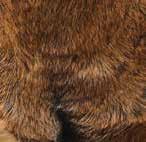


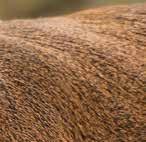
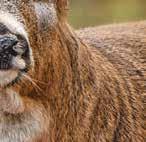
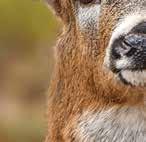

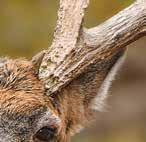
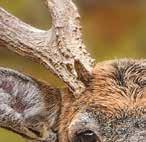
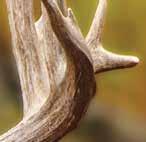

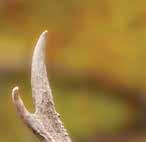

WHITETAIL INSTITUTE SUPPLEMENTS WHITETAIL INSTITUTE 239 Whitetail Trail, Pintlala, AL 36043 • 800-688-3030 • www.whitetailinstitute.com
PLANTING YOUR OWN OAKS
Some land managers might prefer to plant their own oak trees. Although there’s much more to it, this provides some information to start with:
1. You can buy expensive commercial offerings. Or, if you’re good at identifying species, collect some fresh, local acorns to plant.
2. Local acorns are sometimes more resistant to the conditions and diseases than commercial blends.

3. Place each acorn in a bowl of water to test the quality. Those that sink are likely in good shape. Those that float likely won’t germinate.
4. Place acorns in a marked bag with a damp paper towel (keep it that way), and store them in a refrigerator throughout winter. These need to remain in cold storage for 40 to 50 days.
5. Place sprouting acorns in a pot with soil. Keep the soil moist but not too wet, or it can cause the acorns to rot.
6. Pots can be placed outdoors when the seedlings sprout and the fear of freezing is done. Locate them in partial shade. This will help them acclimate to the sun.
7. Keep the seedlings in a large pot for about one growing season. (Don’t allow the root system to outgrow the pot.) Then, when the seedling is about 2 to 3 feet tall and the leaves have emerged again, it’s time to plant.
8. Choose an optimal location for your planting. For most species, this should be a well-drained area that still retains moist soil.
9. Dig a hole that’s twice the size of the root wad. Don’t place trees too close together.
10. Use tubes to ensure a straight-growing tree. Consider necessary precautions to prevent wildlife from browsing young trees.
Shingle oak (R): This is a common tree throughout the Midwest. It does OK in dryer soils. However, it prefers moist but well-drained soil conditions. This tree can reach 70 feet.
Shumard oak (R): This species is less common but exists in greater quantities throughout the South. It’s one of the least predictable when attempting to gauge the acorn drop timeline and often drops very late. This can make it an excellent late-season hunting spot.
Swamp chestnut oak (W): This tree primarily exists in wet to moderate soils and is generally located in bottomlands. It can also tolerate poor drainage. It produces very large acorns, which drop later than many other species.
Swamp white oak (W): This tree gets its name from its geographical preference. It does well in areas of poorly drained soil. This is the reason for its prevalence in swampy areas. That said, it still produces a small, tasty acorn like other white oak species.
Water oak (R): This is a big tree, commonly found in lowlands, and can grow to nearly 100 feet. You might also find it near other waterways, such as ponds, creeks and streams.
White oak (W): This is the favored species of whitetails. Its acorns are sweeter and offer great nutrients. This tree does well on high ground and even down in the bottoms, so long as the soil is well-drained.
Willow oak (R): This tree tends to grow well in wetter soils and can even tolerate occasional, mild flooding. It’s great to have, especially given the timing of the acorn drop. It tends to fall after sawtooth acorns but before the white oak species.
Hunting Around Oak Trees
All things considered, oak trees are incredibly important to deer and deer hunting. Recognizing them and understanding when they drop acorns is pivotal in how deer use and maneuver through the landscape. Being one step ahead of whitetails as they shift to each of these all-important food sources can help you fill tags this season. All thanks to knowing your oaks.
52 Whitetail News | Vol. 32-2
 ■ by Gordy Krahn
■ by Gordy Krahn
HUNT WHEN YOU CAN

David Reitz didn’t let bad weather hamper his pursuit of a trophy Pennsylvania buck. In fact, his rainy-day hunt over a Whitetail Institute food plot proved to be memorable.
Timing can be everything when trying a tag to a mature whitetail buck. Sure, food plots, stand placement, scouting, camera intel and weather conditions are critical factors. But when the rubber meets the road, most hunters have to play the cards they were dealt any given day during the hunting season. And sometimes, that means hunting when they can, not necessarily where and when they would like. So, when David Reitz faced down the huge buck he’d seen on the family farm only a few days earlier, it was more by happenstance than by design.
“It’s funny, but if I had any other day that week to hunt, I probably wouldn’t have been in that stand,” said Reitz, whose family owns a 350-acre farm in Pennsylvania’s heartland that he, his dad, his brother and a couple of friends manage for whitetails. “But with the kids’ practice schedules and my work schedule, it was the only day that week I could hunt.”
And that afternoon, the hunter had an important decision: Should he hunt in questionable weather conditions and in a popup blind where he hadn’t sat all season?
“It was rainy and blowing a bit, but the wind was coming out of the northwest, across the food plot toward the blind, and I thought, ‘You know, the wind’s right, and at the very least I’ll stay dry in the blind.’”
So, on the afternoon of Tuesday, Oct. 26, 2021, Reitz grabbed his bow and headed to the blind. It didn’t take long before he realized he’d made a good decision.
Pennsylvania has a rich hunting heritage, and like many youngsters who grew up in the rural reaches of the Keystone State, Reitz spent time in the woods with his dad and siblings long before he was old enough to legally hunt.
“In Pennsylvania, you couldn’t get a license until you were 12,” Reitz said, “but I grew up enjoying the outdoors, and as a kid I always liked being in the woods. It’s just something that’s part of our culture, part of our heritage, part of our way of life here.”
Reitz began hunting deer in earnest when he turned 12, after completing the state’s required hunter safety course.
“I was super excited to get my license,” he said. “The first year, I hit a big buck, but it ran off, and we couldn’t retrieve it. It was my third year of hunting when I got my
first buck.” Those early years set the hook and would lead to the lifetime of pursuing whitetails — and fueled a passion that would take those efforts to the next level of commitment.
The Reitz Family Farm
“My dad is the fifth generation to own this farm, so it’s been in our family for quite a while,” Reitz said, explaining that the homestead is more of a hobby farm nowadays. “We have 20 or so cows, and we raise a pig every year. We make hay and grow some small grains but nothing major. I don’t live on the farm, I live a little ways away, but it’s been my primary hunting area most of my adult life.”
The Reitz farm consists of about 80 tillable acres, the rest a mixture of pasture, hardwoods, pines and hemlocks, with some creeks running through it.
“We don’t do much grain, and we don’t do corn and beans,” Reitz said. “We’re a grass and beef operation. So there are the hay fields, and there are chunks of fields that are fallow that we don’t use.”
In other words, prime whitetail habitat, just waiting to happen.
“Primarily, it’s my dad, my brother, my cousins and my uncles and a few family friends who hunt the property,” Reitz said. “But during archery season, it’s just my brother, myself and two friends.”
The family was killing deer on the farm, but Reitz knew they could do better, especially in the quality of deer they were seeing. And with agricultural land surrounding them, they needed a way to attract and hold deer on the property. They needed food plots.
“A few years ago, we decided things weren’t going the way we needed them to,” Reitz said. “We had to try something to keep up with the people around us, because they were shooting more and bigger deer than we were, and we wanted to swing the ball in our favor a bit. We talked to Dad and said, ‘OK, we need to put in some food plots.’ For starters, we chose an old, overgrown 2-acre pasture we call the Bullpen, where my grandfather kept his bulls back in the ’60s. We don’t do anything with it anymore, so it was an easy choice. “I told the guys, ‘Hey, if we’re going to do this, it has to be done right.’”
Vol. 32-2 | Whitetail News 55
So Reitz reached out to the folks at Whitetail Institute, explained what his family was trying to accomplish and asked for the consultant’s advice. The family used several Whitetail products before settling on Beets & Greens as their go-to.

“We’ve done Winter-Greens, Pure Attraction, Imperial Whitetail Clover and Fusion, but Beets & Greens is by far our favorite,” Reitz said. “It’s just like the videos you see on TV. They’re pulling the whole thing out of the ground and chewing on it, and leaves are hanging
out one side of their mouth, and a beet or turnip hanging out the other side. I don’t want to say it’s amazing, but it’s amazing how well it works.”
Whitetail Institute Beets & Greens is a blend of annual seed varieties — kale, turnips and radish varieties, as well as the sweet attractiveness of sugar beets — designed to work together to attract and hold deer. These components are present in ratios that Whitetail Institute testing has proven will provide abundant, highly attractive tonnage from early fall through late winter, as well as tubers
to help deer through the harsh winter months.
Designed for planting in fall, Beets & Greens establishes and grows quickly. Reitz said that putting the food plots into play was relatively easy: Get a soil test, spray it, and then come back and till it up, fertilize it and put down the seed. “It might sound cliché, but just follow the instructions,” he said.
But managing those plots and preparing them to optimize their hunting stands didn’t stop there. This past year, the hunters added screening to provide a visual barrier that would let them get and from their stands undetected while shielding the plots from a nearby road. “We didn’t just put up a straight line of screening,” Reitz said. “We put a turn in it so you could access it from the parking area and come up over a hill and get in behind the screening, so you’re pretty much hidden the entire time.”
In addition to Egyptian wheat, they used Whitetail Imperial Conceal to build those corridors. Conceal can grow 8 feet or taller, and it’s designed with components that grow to various heights, ensuring that it’s thick from top to bottom.
Closing the Deal
Blustery conditions aside, Reitz was hunting the ground blind Oct. 26 because he had seen a big buck while hunting from another stand the previous Friday and bumped it on his way out in the dark. “Two bucks came out right at dark across the plot from me,” he said. “I couldn’t get them to come in, and when I climbed out at dark, I spooked one of them.” And the next day, his two hunting buddies saw the same bucks in a hay field feeding with some does.
Settled into the popup blind, Reitz watched some does milling around the food plot. And then another doe came out from up the hill to his right, followed by a small buck.
“I watched those two deer feed for 20 minutes or so, and they were joined by some other does,” Reitz said. “That little buck fed his way toward brush in the bottom that goes to a ravine, and I couldn’t see him out of my peripheral anymore, so I slid over in my chair to have a better look. And that’s when I saw the big buck — just standing where he must have come out of the ravine. He
56 Whitetail News | Vol. 32-2
■ David Reitz’s Pennsylvania 11-pointer scored more than 134 inches.
paid no attention to that little buck, and he didn’t even care about the does. He was simply there to eat.”
The buck was at about 55 yards, but with the windy conditions, Reitz decided he wouldn’t take a shot of more than 40 yards. So he patiently waited as the buck slowly fed toward him. “I watched him for about a half-hour,” he said, “and at that point, he was about 47 yards away. One of the does was feeding from my left to right coming toward the blind, and she was getting really close. She’d feed and look at me, and feed and look at me, and I thought, ‘Man, she’s going to ruin this.’ And sure enough, she got past me and started to exit the plot, that’s when the buck stopped feeding, and he’s like, ‘Wait, where’s she going?’ And he started walking right toward her.”

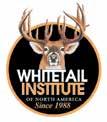

And right toward Reitz. “He got to about 34 yards, and I bleated and
stopped him,” Reitz said. “I drew on him and let my arrow fly.” The buck bolted, exited the food plot and ran into the woods. “I heard some crashing, so I waited for about 45 minutes, but it started to rain, so I gathered my stuff and went after him. Reitz hadn’t gone far when he heard the buck get up and go. “I found a big blood pile, but I lost the blood trail,” he said.
He had little choice but to back out and get help. Reitz called a guy with blood trailing dogs, and they found the deer about 120 yards from where he had shot it, but it was still alive. “I was pretty sure I’d caught the liver so I thought, ‘I’ll come back in the morning.’ Thankfully, it was a cool night, and we found him dead the next morning, right where we’d left him.”

All the hard work had paid off, and Reitz had anchored his biggest buck ever — a handsome 134.25-inch home-
grown Pennsylvania 11-pointer. Reitz said it’s been rewarding to see the fruits of his family’s labor pay off. “We’re a close group of friends and family — we enjoy each other’s company and we enjoy getting together and doing stuff,” he said. “We’re always bouncing ideas off each other, and we get together in the summer and plant the food plots, move stands, clear shooting lanes and clean up around the edges of the food plots. And with the addition of food plots as part of our [deer management] program, we’ve also adjusted the way we hunt — the way we approach our stands and even where we put them. To see it all pull together has been something special.”
SEE IT ALL PULL TOGETHER HAS BEEN SOMETHING SPECIAL.” “ WHITETAIL INSTITUTE HERBICIDE RESULTS RESEARCH EQUALS The Choice is Clear. Our Herbicides are researched and developed to produce high-quality plots. Less weeds means more quality food and simply more deer. ORDER TODAY! 800-688-3030 www.whitetailinstitute.com 239 Whitetail Trail, Pintlala, AL 36043
“TO
EIGHTEEN ACRES AND A DREAM

How a New York hunter carved a food plot out of nothing and killed his best archery buck.


58 Whitetail News | Vol. 32-2
There’s not much better in whitetail than tagging your biggest archery buck. But if that buck came to a food plot you carved out of brush and rocks, and had invested the time, money and sweat equity required to make it a whitetail magnet, that’s another level of special.

That’s exactly what Patrick Funk did this past fall at his property near Hobart, New York.
“When I retired from the Navy in November 2013, I bought a place back home in Hobart that came with 18 acres of land,” Funk said. There was a lot of swamp behind my house, but there was also a pretty good-sized piece that I thought would make a great food plot. Deer make their way through the valley all the time, and I believed a good plot would be the key to getting some shots at them.”
Of course, carving a food plot out of rough country carries many challenges, and Funk had more than his share.

“The first problem was I didn’t have the money set aside to get it done, and then when I did have the money, it proved almost impossible to get somebody there to clear the land, because it wasn’t a huge job, and they were pretty backed up with the big, high-paying gigs,” he said. “That finally changed last year, when a good friend of mine said he’d be happy to help me. He secured a small excavator and went to work on clearing the land. Then another good friend said he’d be happy to help since he had all the equipment and just asked that I pay for fuel.
“Once the land was clear, the plan was to pick whatever rocks and sticks out that we could see, and then we’d bush-hog it to get the weeds down low. We also wanted the weeds to start regrowing well so when we sprayed them, they would readily take in the herbicide, and we’d get a good kill. So we picked rock, bush-hogged, and picked again after we could see them a little better, and sprayed a week later. About two weeks later, we put down 4 tons of lime, and then I paid a guy to come in and rototill, and once again, we picked rocks.”
Vol. 32-2 | Whitetail News 59
■ by Scott Bestul
Funk grew up on a dairy farm, so he was no stranger to the back-breaking work of removing stone and rock from fields.
“We did this every spring on our family farm, and it was by far the worst job on the farm,” he said. “We joked that God created the Earth in six days, the seventh he rested, and on the eighth he got bored and threw rocks at Delaware County.”
Always ready to listen to the advice of experts, Funk contacted the Whitetail Institute when he thought he’d done the necessary steps to prep the plot.

“I called The Whitetail Institute because I have listened to enough of the pros to know that these were the guys who knew what I needed to do,” he said. “I probably spent 35 minutes on the phone
with the guy just soaking up knowledge. He explained the process of what I needed to do, and we settled on Pure Attraction, an annual that grows best in the fall. So, in late August, we planted, rolled it and just hoped. I did measure afterward, and all in all, the plot was fourfifths of an acre.
“In the meantime, I purchased a new blind, because the ones I have were kind of small, and I didn’t want to hit something with my bow while trying to shoot. I’ve also never hunted out of a blind before, and I wanted to make sure I had plenty of room. When the blind arrived, I set it up two weeks prior to the bow opener, about 3 yards into the brush. The plot is shaped like an L, and I put it on
the inside corner so I could get a shot on both sides. I brushed it in really well, and raked out the inside so I didn’t make any noise stepping on anything. The Pure Attraction was growing extremely well, and I had nothing but solid excitement. Oct. 1 couldn’t come fast enough.”
Funk’s trail cameras, which he’d placed in May, were also picking up plenty of action that proved the Pure Attraction was living up to its name.
“The buck I ended up shooting I actually saw from my house one day,” he said. “That buck and a 7-point that he liked to hang with were in that food plot constantly. But I was getting pics of a really nice 14-point that was at the top of my hit list, too, as well as a couple of other nice bucks. The one I ended up shooting was actually about No. 4 on the list. Still, he was bigger than anything I’d shot with a bow before.”
When the New York archery opener rolled around, Funk was beyond excited.
“Still, it was the only year I didn’t take the opener off from work,” he said. “Because of COVID, my company adjusted my hours from 8 a.m. to 5 p.m. to 7 a.m. to 3:30 p.m. This gave me plenty of time in the afternoon to get out. As soon as I got home, I showered with all my scentfree stuff, jumped in my hunting clothes and headed out. I got into the blind and took my time to arrange everything, and I drew my bow a couple of times to make sure I was clear of everything — including the arrow clearing the windows.
“Once I was finally set up, I didn’t have to wait very long. Ten minutes in, that pair of bucks — the 7- and 8- pointer — that had been hanging around all summer walked into the plot. They slowly made their way toward me, munching the entire time. Every time they lifted their heads, they had food hanging out of both sides of their mouths. They worked their way directly in front of me, and eventually the 8-pointer, which was the bigger of the two, came around to my right at about 20 yards, slightly quartering toward me. I ranged, checked to make sure my arrow would clear the window, and shot. Both of them ran out of the plot, the same place they came in.
“I got out of the blind, and checked the
60 Whitetail News | Vol. 32-2
■ Patrick Funk’s 2021 buck was perhaps the fourth-largest he’d seen on camera but still his largest archery buck to date. And he’s even more excited about the future.
shot area, where I found my arrow lying. It was a complete pass-through with some bubbles in the blood, so I knew I hit a lung. I sent some texts and made some phone calls to let everyone know, and see if anyone could give me a hand tracking. I went back and buttoned up the blind, and saw a rip. I couldn’t believe the window of my brand-new blind was already ripped. And the closer I looked, I realized the rip was self -inflicted. There were three perfect rips where my broadhead passed through.”
Funk returned to his house and changed out of his hunting gear so he wouldn’t have to clean it and eliminate scent before his next hunt.

“About an hour-and-a-half after the shot, my buddy and his girlfriend showed up to give me a hand, and within 100 yards of the shot, we found him,” he said. “This was my buddy’s girlfriend’s first time ever doing a recovery, and she absolutely loved it, and said it was one of the most exciting things she’s ever been a part of. This buck was the fourth biggest I had seen all year,
and I knew I wanted to take him, and everything went perfectly. I can’t say for sure that I wouldn’t have gotten him without the food plot, but I can say for sure I know why he was where he was at that moment in time: Pure Attraction.”
While obviously thrilled about his 2021 season, Funk is even more excited about the future.
“I only have 18 acres, but there’s a bunch of Dept. of Environmental Protection land in the neighborhood, and much of it is archery-only hunting,” he said. “Plus, we have antler point restrictions here, and that has made a huge difference in getting more bucks to grow to maturity. Before APRs, it was really hard to pass on a young buck, because you knew the next guy was going to kill him, and there is just a ton of hunting pressure almost anywhere you go in New York. While APRs weren’t popular with some guys at first, I think most hunters in the area would tell you they were one of the best things to happen here.”
And Funk’s food plot plans will con-



tinue to be an integral part of his hunting plans.
“When I talked to the Whitetail Institute guy last year, we also discussed the following year (2022), and he said if I start early enough, he recommended Fusion, as that is a perennial and should go anywhere from three to five years before having to plant again. I liked the thought of getting a break from tilling and replanting every year.
“I was so grateful to the Whitetail Institute people and their expertise. Honestly, if they told me to go to that food plot and do a handstand twice a day, I’d do it. Words cannot express how truly grateful I am to everybody who helped make this dream a reality. From the friends and family who helped get the plot in, to the guy at Whitetail Institute who spent a ton of time on the phone with me talking about growing deer food, they all had a hand in this. I cannot thank all of them enough.”

Whitetail Institute MAIL TO: 239 Whitetail Trail, Pintlala, AL 36043 CALL TOLL FREE: 800-688-3030 • www.whitetailinstitute.com Don’t want to wait for your kit? Download Your Soil Test TODAY! Instant online access can be found at: https://bit.ly/35KoS7f SOIL TEST KIT Whitetail Institute Soil Test Kits provide the data you need for great food plots. Professional laboratory soil testing is one of the most important things you can do to ensure food plot success. The Whitetail Institute offers professional results and recommendations for all Imperial Whitetail products, as well as other crops. Accurate fertilizer and lime recommendations are provided. Don’t want to wait for your kit? Please send Soil Test Kits at $13.95 each. FREE Shipping and handling Please send Soil Test Probe at $129.00 each. FREE Shipping and handling Add 7% Sales Tax. Cost of kit includes test results and phone consultation. (Results are available 24-48 hours after the laboratory receives the sample.) SHIP TO: Name: Address: City: State: ZIP: Phone: Email: Payment: ❑ Check or Money Charge to: ❑ Visa ❑ Mastercard ❑ Discover ❑ AMEX Credit Card: Exp. Date: Sec.Code: Signature: (No PO Boxes) Order enclosed
HOME ON THE RANGE
Create core areas rather than just locating them. Learn to recognize what deer want, and then make that happen.

 ■ by Bob Humphrey
■ by Bob Humphrey
62 Whitetail News | Vol. 32-2
If you hunt the same general area for years or decades, you begin to notice certain special places — honey holes that seem to produce more consistently than others.


Sometimes, the reasons are obvious, but often, they’re more subtle. You can’t quite tell why, but such spots just seem to hold more deer year after year. As noted, it often takes time to find them. You can accelerate the process a bit with intensive scouting and trail cameras, but it would be much easier if you could recognize those hotspots even without deer sightings. After you learn to identify those spots, you can then go a step farther and create them. Find out what makes a place special to deer, and if you build it, they will come.
Too often, hunters focus on locating home ranges and core areas of certain deer (bucks). That’s effective from one year to the next, but a better long-range approach might be manipulating your habitat to make it more attractive — that is, building perennial core areas. Research has shown that although bucks have individual home ranges and core areas, they often overlap, particularly in areas of prime habitat.
Home Ranges and Core Areas
Let’s start with some defining parameters so you know what we’re talking about. A deer’s home range is defined as where that animal spends 95 percent of its time during a year. People often cite a square mile as the average home range for a whitetail. That’s actually a reasonable estimate but can be misleading because it’s an average. For every home range that’s smaller, there’s another that’s larger, and the differences can be considerable. Studies from Louisiana, Maryland and Pennsylvania showed home range sizes for adult bucks averaged about 250 to 500 acres. Meanwhile, a Texas study found home ranges averaging more than 2,000 acres. Home range size is influenced by several variables, especially habitat, but more on that later. It’s also important to remember this includes where a buck traveled on excursions during the rut.
Within that home range is a core area, where a deer spends at least 50 percent of its time. Deer might travel far from home during the rut or as diet and food sources shift, but they’ll spend most of their time in a relatively small area. Several of the aforementioned studies showed core areas of less than 100 acres. Find these core areas and your odds of encountering the deer that inhabit them increase, provided you keep human disturbance to a minimum.
Let’s return to those excursions for a moment. Not surprisingly, does tend to have smaller home ranges than bucks, because the latter leave home looking for love when the season is right. So your odds of finding a buck in its core area are better before and after the rut. During the rut, all bets are off, because a buck might show up almost anywhere, right?
Vol. 32-2 | Whitetail News 63
MORE ON CORE AREAS
Although it’s somewhat of a generality, does typically disperse in what biologists refer to as a rose petal pattern. When a young doe finally reaches breeding age, she’ll leave her natal core area and establish a new one nearby, often adjacent or even overlapping that of her mother’s. Successive generations will do likewise, and vacancies are quickly filled when a doe is removed — particularly an older doe that has probably secured the best habitat.
Bucks behave somewhat differently. They disperse as yearlings and might end up far from home before establishing a core area. When they do, it’s usually in prime habitat, where food is close to cover. And they don’t mind company, which is why you commonly see bachelor groups in late summer and early fall. They’ll be less tolerant of each other during the rut, but only for a relatively brief period. Then it’s back to the boy’s club.
Not necessarily. Young bucks tend to travel farther and wider, especially yearlings that are dispersing from their natal home range. Studies have found that mature bucks don’t stray as far from home, and some might only use 30 percent of their home ranges during the rut. This is likely in part because of experience. They have learned where to find does. Even more interesting are results from studies on mature bucks fitted with satellite tracking collars. Researchers found the destinations of their excursions often overlap in the core areas of does.
Bottom line: Does inhabit their core areas year-round. Bucks inhabit their core areas most of the time but leave briefly during the rut, and older bucks don’t go as far as younger ones. When they leave, they go to the core areas of does. The question then is, what makes one area more attractive than another as a core area?
The answer, in a word, is habitat, which is defined as food, water, cover and the juxtaposition of those elements. The better the habitat, the more likely deer will establish a core area. If you do it right, you can hold a lot of deer in a relatively small area.


Food
Let’s start with food. There’s ample information on specific plantings on the other pages of this and past issues of Whitetail News, so we can skip those and talk in generalities. The most important thing is to provide enough of the right types of food to meet a deer’s year-round nutritional requirements. If your ground lacks anything, deer will go elsewhere to find it, and if they find something better, they might not be back.
In general, you want a sufficient amount of perennials so that at least some of your food plots will provide food from the first green-up. Imperial Whitetail Clover and Fusion will probably be your go-to varieties, but there are others. When conditions allow, you can supplement existing food with warm-season annuals such as PowerPlant, sunn hemp and others. All of those will carry deer through the abundance of midsummer and the smaller nutritional gap of late summer.
64 Whitetail News | Vol. 32-2
Next comes your late summer-fall planting. Although the focus will be mainly on cool-season annuals for attraction, you’ll want to make sure to plant enough species that will persist into winter, such as Winter Peas Plus, Pure Attraction and Beets & Greens, the latter of which will provide abundant food when it’s most needed. And don’t be afraid to add or top-seed with more perennials to ensure fast, early green-up the next spring.
If you have enough ground, you should be able to meet most nutritional needs with food plots, but adding hard and soft mast will make your ground richer and more attractive. If you already have hard mast species such as oaks on site, you can promote better mast production by removing undesirable species that compete for soil moisture, minerals and sunlight. Volunteer species such as raspberries and blackberries will usually pioneer in disturbed areas such as recent cutovers if you’re also managing for timber, and those provide great cover. Plum thickets and persimmon patches also perform dual duty.




Speaking of cover, it’s the next most important habitat element in encouraging deer to establish core areas on your property. It might even be equally important to food when you consider that deer spend far more time bedding than they do feeding. Make sure you have enough and in close proximity to feeding areas. An ideal situation might be a wide strip of dense shrubby cover, fallow field or CRP between your food plot and forest. It might be easier and more efficient to plant larger plots, but smaller is often better. It creates more diversity and more of the edge habitat deer prefer.
If you manage for timber, much of your forest will be in even-aged stands. In that case, it’s preferable to rotate your harvesting so you have a diversity of age classes in various stands and you’re cutting smaller blocks during a longer period. This also creates more diversity by having a variety of young, middle-aged and mature stands rather than having all

“ www.whitetailinstitute.com 239 Whitetail Trail, Pintlala, AL 36043 BREAKING GROUND FREE E-NEWSLETTER!
“YOU MUST PROVIDE ENOUGH OF THE RIGHT TYPES OF FOOD TO MEET THE YEAR-ROUND NUTRITIONAL REQUIREMENTS OF DEER.”
SAMUEL RICKER | Michigan
■ Every year, my friend and I are amazed at how well Whitetail Institute products continue to produce nice bucks in high-pressured areas of southeastern Michigan. Our top three products in which we love to see deer year-round are Imperial Whitetail Clover, Beets and Greens and Winter-Greens.


GROWING GREAT BUCKS
66 Whitetail News | Vol. 32-2
MY
TROPHY WHITETAILS
■ In 2008, we started using Whitetail Institute No Plow and had great success with it. Through time, my dad and I acquired more equipment. We now use Beets and Greens, Vision, Fusion, Whitetail Clover and Pure Attraction. We hunt in Halifax County, North Carolina. We have had good luck with all the Whitetail Institute products we’ve used. The product we have used that has had the biggest impact has definitely been Imperial Whitetail Clover. We planted roughly 15 acres on our club land in 2015 and 2016, and the mass on the bucks we killed starting in 2017 to this year has definitely improved. The mass was the main difference we could tell, as well as increased body fat on the deer we harvested. We have been using some frost seeding techniques and are looking at doing a major replant now that we are six to seven years into the last main clover planting. I cannot say enough good things about it.


■ We’ve had much success using all the Whitetail Institute products we have tried. Deer here in Ohio really love “Chic” Magnet and Imperial Whitetail Clover. Alfa Rack did wonders for keeping deer around all year. The past 10 years, there have been 10 to 12 bucks staying in the small plot of woods among much tilled land. We’ve had many deer staying around and wintering here. They love the clover and eat a lot of it. I have planted chicory also, and they eat the roots and all. I’ve watched them many times. You have the best products on the market. Thanks very much.



Vol. 32-2 | Whitetail News 67
MATTHEW SEVERNS | Ohio
CURTIS CONE | North Carolina
■ Using Whitetail Institute products the past eight or nine years has changed how I hunt. Now the deer come to me. All I have to do is provide enough food, sit tight in my Redneck Blind and wait. The customer service at Whitetail Institute is second to none. Every time I have called with a question, they have given 100 percent effort to help my food plots be successful. I currently have three food plots for a total of five acres, and it’s not uncommon for me to see more than 20 deer during an average evening sit. Fusion seems to be what deer at my Greencastle, Indiana, property prefer.



■ I started planting food plots in 2016. The first couple failed, but I was not using Whitetail Institute products at that time. The next year, I started using Whitetail Institute seed and have been using it since. The most important step is to start with a soil test, which Whitetail Institute sells. You usually get your results emailed back in three to five business days. It takes all the guesswork out. Consider a soil test as the blueprint to your food plot build, and do what is recommended for maximum results. I have used many Whitetail Institute blends, and they all worked awesome. I never had any Whitetail Institute plots fail. I was hooked. The first year, I saw more deer at my place than ever before, which in turn brought in more bucks looking for does during the rut. I cleared more land and built more plots the next year, and yes, I soil sampled and did what was recommended. That year, I saw even more deer, bigger bucks and bigger-bodied does. Even more turkeys were visiting on a regular basis. The results speak for themselves. I have a mix of perennial and annual plots so deer always have something to feed on. To date in 2022, my eight plots range from 1/8 acre to 1.5 acres. If you’re new to food plots, I would recommend starting with a couple of smaller plots rather than one big plot. Then you can learn and gain some knowledge before taking on more than you can handle. Second, ½-acre food plots do not cost a ton of money to plant, and if one fails, you’re not losing piles of money, and it’s a lot easier to replant than a big plot. Soil tests are a must. If you want to see more deer, bigger bucks and bigger bodies, and have a healthier herd, planting food plots with Whitetail Institute is your answer. Whitetail Institute not only sells the best seed on the market, but offers professional advice on social media or on the phone. You can actually call and talk to a real person and get professional advice. No other seed company does that. Whitetail Institute has gone above and beyond and takes great pride in its product and service. “Research equals results” isn’t just a slogan. It’s a fact Whitetail Institute has proven.

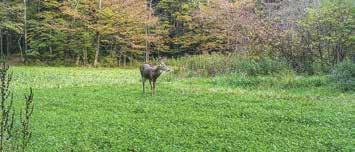


68 Whitetail News | Vol. 32-2 MY TROPHY WHITETAILS
BEN CHESTNUT | Indiana
IMPERIAL WHITETAIL PLEASE SCAN HERE AND TAKE A QUICK SURVEY • https://whitetailinstitute.com/field-tester-survey/
JAMES WEBSTER | Pennsylvania
■ I’ve been using your products for years. If you keep the does around, the bucks will follow.



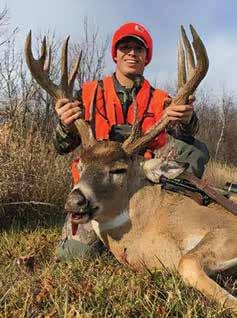


Vol. 32-2 | Whitetail News 69 MY TROPHY WHITETAILS
■ We have tried many of your products through the years and have had good results from all. The best results have come with Tall Tine Tubers and “Chic” Magnet.
■ Whitetail Institute has great products and excellent service.
Wishing you a prosperous and happy 2022 from Maine.
STEVEN MARKWITH | Maine
CRAIG FISH | Illinois
WIN WORRALL | south Carolina
■ I started using Whitetail Institute products more than 20 years ago. We’ve seen a dramatic increase in the number of deer and an increase in body and antler size. My hunting buddy always comments on the size of our deer compared to his (40 minutes away) land. We have harvested some nice deer, and quite a few have eluded us. Whitetail Institute food plots have helped keep our youth hunters engaged and created lasting memories, with an 8-year-old hunter harvesting a 168-inch buck with a rifle. We credit Whitetail Institute products, hard work and patience for our success.





■ The past several years, my focus has primarily been on Imperial Whitetail Clover, Beets and Greens and Whitetail Oats Plus. In Summer 2020, my hunting camp decided to shut down food plots, but the effects of the past several years were still present. This past fall, I took my 7-yearold son hunting for his first time. You could sense his excitement. On the opening of archery season, the first weekend of October, he saw one of the largest 8-point bucks I have ever seen in my 26 years of hunting. Although I didn’t get a shot that night, the ability to show a youngster the thrill of seeing a deer like that on his first time is truly a blessing. I didn’t harvest that deer, but I took a doe two weeks later during Pennsylvania’s muzzleloader season. This would not have been possible without the incredible products from the Whitetail Institute. In a year that has seen more downs than ups, we need to remember that we have a lot to be thankful for.
■ This picture is of my 10-year-old son, who killed his first buck this year over a food plot planted in a mixture of Imperial Clover and Pure Attraction. I have four food plots at this property, and two of the four are planted with Imperial Clover and Pure Attraction. Both of the plots had a dramatic increase in deer activity compared to the other two plots. I plan on planting PowerPlant in the other two this summer and all four in Whitetail Institute products for 2022.



70 Whitetail News | Vol. 32-2 MY TROPHY WHITETAILS
■ You guys have the best food plot seeds on the market and help us grow bigger, healthier deer year after year. Thank you, guys.
MATTHEW COOLEY | Texas
RICH SAYLOR | Pennsylvania
CHANDLER BARNERS | Kentucky
CHRISTOPHER SNYDER | Pennsylvania
7
Call

Apr 15 - June 15 Aug 1 - Sept 1
Coastal: Feb 1 - Mar 15 Sept 1 - Oct 15 Southern Piedmont: Feb 15 - Apr 1 Aug 15 - Oct 1 Mountain Valleys: Mar 1 - Apr 15 Aug 1 - Sept 15



Feb 1 - Apr 1 Aug 1 - Sept 30
Feb 1 - Apr 15 Sept 1 - Nov 1
8 Apr 1 - June 15 July 15 - Sept 5 9 Apr 1 - May 15 Aug 1 - Sept 15 10 Mar 20 - May 15 Aug 1 - Sept 15 11 Sept 15 - Nov 15 12 Feb 5 - Mar 1 North: Sept 5 - Nov 15 South: Sept 25 - Nov 15 13 Feb 15 - Apr 1 Sept 1 - Oct 30 14 North: Sept 15 - Nov 15 South: Sept 25 - Nov 15 15 Feb 1 - Mar 1 Coastal: Sept 25 - Oct 15

Piedmont: Sept 1 - Oct 5
Mountain Valleys: Aug 25 - Oct 15
16 North: Sept 25 - Nov 25
North: Aug 1 - Sept 30 South: Aug 15 - Oct 15
July 15 - Sept 5
Aug 1 - Sept 15
Aug 1 - Sept 15
Sept 15 - Nov 15
North: Sept 5 - Nov 15 South: Sept 25 - Nov 15
Sept 1 - Oct 30
North: Sept 15 - Nov 15 South: Sept 25 - Nov 15
Coastal: Sept 15 - Oct 15 Piedmont: Sept 1 - Oct 5
21
May 15 - July 1
18
19
20
21
22
Mountain Valleys: Aug 25 - Oct 15
North: Sept 25 - Nov 25 South: South: Oct 5 - Nov 30


Aug 1 - Sept 15
Aug 1
Sept
Mountain Valleys: Aug 5 - Sept 15
North: Sept 15 - Nov 15 Central: Sept 25 - Nov 15 South: Oct 5 - Nov 30
July 15 - Sept 1
Aug 1 - Sept 30
July 1 - Aug 15
June 15 - Aug 1
July 15 - Aug 31
July 1 - Aug 15
FOOD P LOT PLANTING DATES…
WHITETAIL
Use the map above as a guideline for when to plant Imperial
Plus in your area. For best results, wait to plant until
has
and
to provide abundant
and
in colder
PLANTING DATES FOR
OATS PLUS
Whitetail Oats
excessively hot, droughty summer weather
passed. Imperial Whitetail Oats Plus is highly cold-tolerant
designed
forage from fall into spring in the southern U.S.
from fall into winter
climates.
PLANTING DATES FOR POWERPLANT, REVIVE CONCEAL, SUNN HEMP AND TURKEY SELECT *Do not plant PowerPlant, Sunn Hemp or Conceal until soil temperatures reach a constant 65 degrees F. Wait as long as necessary for soil temperatures to reach a constant 65 degrees F before planting. FOR THE LATEST PROMOTIONS, SALES AND NEWS VISIT WWW.FACEBOOK.COM/WHITETAILINSTITUTE PLANTING DATES FOR IMPERIAL CLOVER, ALFA-RACK PLUS, EXTREME, NO-PLOW, FUSION, CHIC MAGNET AND EDGE May 20 - June 30 May 1 - June 30 April 1 - May 31 1 Call for planting dates 2 Call for planting dates 3 Aug 1 - Sept 15 4 Coastal: Sept
- Oct 15 Piedmont:
-
Mountain Valleys:
5
-
6
7
8
9
10
11
12
13
14
15
16
17
PLANTING DATES FOR VISION, PURE ATTRACTION, SECRET SPOT,WINTER PEAS, BOWSTAND, AND DESTINATION PLANTING DATES FOR WINTER-GREENS, TALL TINE TUBERS, BEETS & GREENS AND RAVISH RADISH 1
for
2
3
4
5
Aug 15 - Sept 15 Sept 15 - Nov 15 Sept 1 - Oct 1 6
1
Aug 15
Oct 1
Aug 1 - Sept 15
Aug 1
Sept 30
Aug 15 - Nov 1
Aug 20 - Sept 30
July 1 - Aug 15
June 15 - July 15
July 15 - Aug 31
July 1 - Aug 15
planting dates
Apr 1 - July 1
North: Mar 15 - May 1 Aug 1 - Sept 15 South: Mar 1 - Apr 15 Aug 15 - Oct 15
22
1 Call for planting dates 2 Call for planting dates 3 July 1 - Sept 1 4 Coastal: Aug 15 - Sept 30 Southern Piedmont: Aug 1 -
15 Mountain Valleys:
-
5 July
-
6
-
1 7 North:
-
South:
8
9
10 July
-
11
12
13
14
15
16
17
18
19
20
21
South: Oct 5 - Nov 30 17 Mar 1 - May 15 Aug 1 - Sept 15 18 Feb 1 - Apr 15 Aug 20 - Sept 30 19 Apr 15 - June 15 July 1 - Aug 15 20 May 15 -July 1 22
May 1 - June 15 July 1 - Aug 15
Sept 15
15
Sept 15
Aug 1
Oct
July 15
Sept 15
Aug 1 - Oct 1
July 5 - Aug 20
July 1 - Aug 30
15
Sept 15
Sept 15 - Nov 15
North: Sept 5 - Nov 1 Central: Sept 15 - Nov 15 South: Sept 25 - Nov 15
North: Aug 15 - Oct 1 South: Sept 5 - Oct 15
North: Sept 5 - Oct 30 Central: Sept 15 - Nov 15 South: Sept 25 - Nov 15
Coastal: Sept 1 - Oct 1 Piedmont: Aug 15 - Sept 20









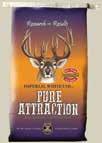
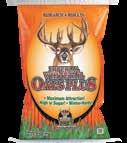


ORDER TODAY! DISCOUNT COUPONS SHIPPING INCLUDED IN PRICES IMPERIAL WHITETAIL Clover $249.99 + tax Suggested Retail $279.96 — (36 lb.) quantities of Imperial Whitetail Clover TOTAL (Add 7% Sales Tax) $ 36 LBS.-4.5-ACRE PLANTING IMPERIAL WHITETAIL EXTREME $246.98 + tax Suggested Retail $289.96 — (46 lb.) quantities of Imperial Whitetail EXTREME TOTAL (Add 7% Sales Tax) $ 46 LBS.-2-ACRE PLANTING IMPERIAL WHITETAIL CONCEAL $119.98 + tax Suggested Retail $139.99 — (28 lb.) quantities of Imperial Whitetail Conceal TOTAL (Add 7% Sales Tax) $ 28 LBS.-1-ACRE PLANTING IMPERIAL WHITETAIL FUSION $246.99 + tax Suggested Retail $289.96 — (27.75 lb.) quantities of Imperial Whitetail Fusion TOTAL (Add 7% Sales Tax) $ 27.75 LBS.-4.5-ACRES PLANTING $114.98 + tax Suggested Retail $120.00 — (50 lb.) quantities of Imperial Whitetail PowerPlant TOTAL (Add 7% Sales Tax) $ 50 LBS.-1.5-2-ACRE PLANTING IMPERIAL WHITETAIL PURE ATTRACTION $59.99 + tax Suggested Retail $89.97 — (26 lb.) quantities of Imperial Whitetail Pure Attraction TOTAL (Add 7% Sales Tax) $ 26 LBS.-.5-ACRE PLANTING IMPERIAL WHITETAIL WINTERGREENS $189.98 + tax Suggested Retail $219.96 (24 lb.) quantities of Imperial Whitetail Winter-Greens TOTAL (Add 7% Sales Tax) $ 24 LBS.-4-ACRE PLANTING IMPERIAL WHITETAIL “CHIC” MAGNET $99.99 + tax Suggested Retail $139.94 — (9 lb.) quantities of Imperial Whitetail “Chic” Magnet TOTAL (Add 7% Sales Tax) $ 9 LBS.-3-ACRE PLANTING IMPERIAL WHITETAIL TALL TINE TUBERs $164.98 + tax Suggested Retail $199.96 — (24 lb.) quantities of Imperial Whitetail Tall Tine Tubers TOTAL (Add 7% Sales Tax) $ 24 LBS.-4-ACRE PLANTING IMPERIAL WHITETAIL OATS PLUS $59.98 + tax Suggested Retail $79.98 — (45 lb.) quantities of Imperial Whitetail OATS Plus TOTAL (Add 7% Sales Tax) $ 45 LBS.-1/2-ACRE PLANTING IMPERIAL WHITETAIL ALFARACK PLUS $246.98 + tax Suggested Retail $289.96 — (33 lb.) quantities of Imperial Whitetail Alfa-Rack Plus TOTAL (Add 7% Sales Tax) $ 33LBS.-2.5-ACRE PLANTING IMPERIAL WHITETAIL No-PLOW $134.98 + tax Suggested Retail $154.96 — (36 lb.) quantities of Imperial Whitetail No-Plow TOTAL (Add 7% Sales Tax) $ 36 LBS.-2-ACRE PLANTING YOU SAVE $29.97 YOU SAVE $20.01 YOU SAVE $5.02 YOU SAVE $29.98 YOU SAVE $34.98 YOU SAVE $42.98 YOU SAVE $42.98 YOU SAVE $42.97 YOU SAVE $29.98 YOU SAVE $39.95 YOU SAVE $20.00 YOU SAVE $19.98 IMPERIAL WHITETAIL POWErPLANT SOLD OUT! Call1-800-688-3030opt1topre-bookfor2023 SOLD OUT! Call1-800-688-3030opt1topre-bookfor2023

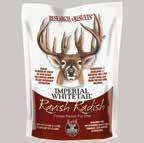

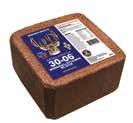
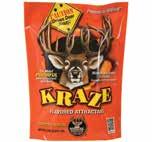




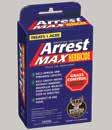
SHIP TO: Name: Address: City: State: ZIP: Phone: Email: Whitetail Institute MAIL TO: 239 Whitetail Trail, Pintlala, AL 36043 CALL TOLL FREE: 800-688-3030 • www.whitetailinstitute.com Payment: ❑ Check or Money Order enclosed Charge to: ❑ Visa ❑ Mastercard ❑ Discover ❑ AMEX Credit Card: Exp. Date: Sec.Code: Signature: (No PO Boxes, Cannot Ship to Canada) IMPERIAL WHITETAIL WINTER PEAS PLUS $129.98 + tax Suggested Retail $149.96 — (44 lb.) quantities of Imperial Whitetail Winter-Peas Plus TOTAL (Add 7% Sales Tax) $ 44 LBS.-1-ACRE PLANTING IMPERIAL WHITETAIL RAVISH RADISH $79.96 + tax Suggested Retail $94.96 — (10 lb.) quantities of Imperial Whitetail Ravish Radish TOTAL (Add 7% Sales Tax) $ 10 LBS.-1-ACRE PLANTING IMPERIAL WHITETAIL DESTINATION $129.98 + tax Suggested Retail $137.02 — (36 lb.) quantities of Imperial Whitetail Destination TOTAL (Add 7% Sales Tax) $ 36 LBS.-1-ACRE PLANTING IMPERIAL WHITETAIL 30-06 block $34.98 (one block) Suggested Retail $39.95 $57.98 (two blocks) Suggested Retail $69.95 + tax — (2) -Pak blocks @ $57.98 — (1) -Pak blocks @ $34.98 TOTAL (Add 7% Sales Tax) $ IMPERIAL WHITETAIL Magnet Mix Block $32.99 (one block) Suggested Retail $39.95 $57.98 (two blocks) Suggested Retail $69.95 + tax — (2) -Pak blocks @ $57.98 — (1) -Pak blocks @ $32.99 TOTAL (Add 7% Sales Tax) $ IMPERIAL WHITETAIL KRAZE $42.98 (4) pak Suggested Retail $52.99 $59.99 (6) pak Suggested Retail $75.99 + tax — (4) 5lb bags @ $42.98 — (6) 5lb bags
$59.99 TOTAL (Add 7% Sales Tax) $ IMPERIAL WHITETAIL Apple obsession $44.99 (4) pak Suggested Retail $52.99 $64.99 (6) pak Suggested Retail $75.99 + tax — (4) 5lb bags @ $44.99 — (6) 5lb bags @ $64.99 TOTAL (Add 7% Sales Tax) $ ARREST MAX HERBICIDE • 1 PINT-1 ACRE • 1/2 GALLON-4 ACRES IMPERIAL WHITETAIL IMPACT SOIL AMENDMENT • 8.5LBS - .5 ACRES • 25.5LBS - 1.5 ACRES — (8.5lbs) of Impact $59.99 — (25.5lbs) of Impact $149.94 TOTAL (Add 7% Sales Tax) $ + tax $59.99 (8.5lbs) Suggested Retail $39.99 $149.94 (25.5lbs) Suggested Retail $169.95 SLAY HERBICIDE • 4 OZ.-1 ACRE • 1 PINT-4 ACRES YOU SAVE $19.98 YOU SAVE UP TO $16.00 YOU SAVE $15.00 YOU SAVE UP TO $11.00 YOU SAVE $7.04 YOU SAVE UP TO $20.01 YOU SAVE UP TO $11.97 YOU SAVE UP TO $19.02 pint(s) of Arrest Max Herbicide 1/2 gallon(s) of Arrest Max Herbicide TOTAL (Add 7% Sales Tax) $ + tax $56.99 (1 pint) Suggested Retail $69.99 $159.99 (1/2 gallon) Suggested Retail $169.00 4 oz. of Slay Herbicide pint(s) of Slay Herbicide TOTAL (Add 7% Sales Tax) $ + tax $57.98 (4 oz.-1 acre) Suggested Retail $72.99 $149.98 (1 pint-4 acres) Suggested Retail $169.00 YOU SAVE UP TO $11.97 YOU SAVE UP TO $13.00
@
PINE RIDGE RENDEZVOUS
We often seek wild places alone, hoping the journey provides the kind of solitary reflection only a day in the woods can provide. Sometimes, however, we can’t avoid encounters with other folks.
That’s not necessarily bad. Actually, chatting briefly with other hunters and land managers is usually enjoyable. And maybe it makes you realize that you’re never truly alone in the outdoors.

Still, I think back to that spring afternoon and wonder how it happened.
During early May years ago, I met up with buddies Wade and Bird Dog, and we traveled to Manderson-White Horse Creek, South Dakota, to chase turkeys at the vast Pine Ridge Reservation. Our host, Jeff, gave us a quick tour of our quarters and then showed us the countryside. After a brief lunch, Jeff suggested that we grab our gear for a late-afternoon/ evening hunt.
Angling his mud-coated rental car up a long ridge, Jeff waved his finger out the window at pine-studded points and seemingly endless prairie, emphasizing again and again that we had tens of thousands of contiguous acres to hunt that afternoon.
“You won’t see another soul,” he said. “Just don’t get lost.”
And with that, he dropped Wade at a small crossing and drove what seemed like several miles before letting me out atop an open bluff. We’d meet back up after dark somewhere along the access road.
Full of optimism and anxious to stretch my legs, I set out through the timbered hills, stopping now and again to call and listen. And after about an hour, a gobble floated back on the prairie breeze, proba-
bly a few hundred yards to the southwest. I scrambled down a gulley, ascended the next hill and called again, hearing another gobble and excited hen yelping in response. The turkeys were probably two hollows away, but not knowing the terrain and aware of how far Merriam’s sometimes travel to a call, I decided to set up there.
The next half-hour brought intermittent gobbling, but the birds eventually began to drift away. Abandoning my setup, I slipped into a hollow and climbed the next rise. The gobbler responded to my calling but seemed even farther. Not knowing what else to do, I gave chase, descending into another bottom and hoofing up a high, rocky hill. Again, the gobbler responded to my yelping but was apparently walking away.
Falling in behind a departing turkey rarely works, and I knew I had to get ahead of the birds if I’d have any chance of killing one. So, I cut back to the east, found a long ridge near the access road and hot-footed it south, hoping to cut off the birds. Out of breath, I stopped briefly to call and get a fix on the turkeys. Sure enough, the gobbler responded almost directly to the west. With one more move, I might get in good position.
That’s when the gunshot rang out.
I can be obtuse at times, but I realized that hunt was finished. And not knowing who had shot, I didn’t want to stick around. So, I walked back north, hoping to get on another turkey and waiting for nightfall.
I hadn’t walked far when a figure emerged from the timber, hoisting a big gobbler over one shoulder. The figure then stopped and waved. I halfheartedly waved back and suddenly found recognition.

on a vast landscape of several thousand contiguous acres, where we had zero chance of encountering another human, we’d converged on the same turkey, and Wade had killed it.
Soon, we met and compared notes. Wade had heard the turkey at about the time I had, and had walked north to cut it off while I was traveling south to attempt the same maneuver. But Wade had slipped into good position, and the birds walked right down his gun barrel, ending the deal.
At first, I was miffed, which was silly. The improbable hunt had been a great introduction to Pine Ridge, and a good friend had experienced success. Further, we had quite a story about almost bumping into each other in the wide-open Western landscape.
That night, Wade’s air mattress went flat, forcing him to sleep on the hard floor. He laughingly accused me of doing it, seeking revenge for killing the gobbler. I hadn’t — honestly — but he wasn’t convinced. He still isn’t.
No matter. The next morning, we filled our remaining five tags, took pictures and were actually on the road home by noon. The chance rendezvous the previous evening became a footnote to a great trip and a tale we spin often when we get together nowadays.
Tens of thousands of contiguous acres. I still shake my head. And every time I hear a distant shot while turkey hunting, I half expect to see Wade emerge from the timber minutes later, grinning and holding a big longbeard.
74 Whitetail News | Vol. 32-2
BACK-40 NOTEBOOK
~Whitetail News Senior Editor
■ Brian Lovett
You’re never really alone in the outdoors. That even holds true when hunting one of the country’s most remote landscapes.







Attractants
and
that
and
have
flavor enhancers and nose
them apart WHITETAIL INSTITUTE ATTRACTANTS RESULTS RESEARCH EQUALS WHITETAIL INSTITUTE 239 Whitetail Trail, Pintlala, AL 36043 • 800-688-3030 • www.whitetailinstitute.com Still the leader since 1988
contain multiple scent
flavor enhancers, including an ingredient
appeals to the sugar craving of deer delivering an unequaled attraction that can pull deer from surrounding properties
help hold them on your property. These attractants
been researched for unrivaled attraction. Their
stimulating capabilities are what sets































































































 ■ by Gerald Almy
■ by Gerald Almy















 ■ by Josh Honeycutt
■ by Josh Honeycutt

































































 Almy
Almy










 ■ by Josh Honeycutt
■ by Josh Honeycutt

































 ■ by Gordy Krahn
■ by Gordy Krahn

















 ■ by Bob Humphrey
■ by Bob Humphrey






































































